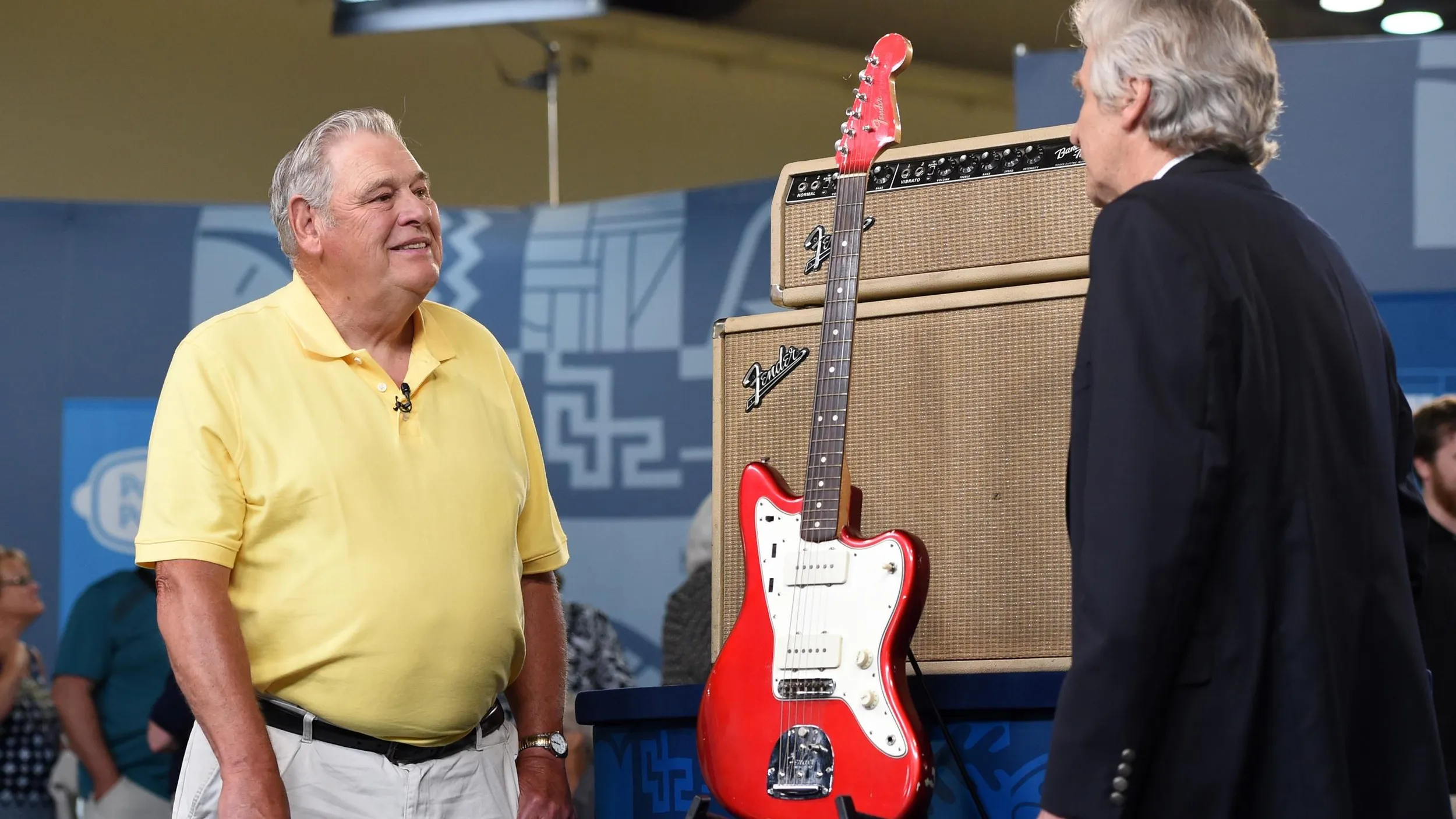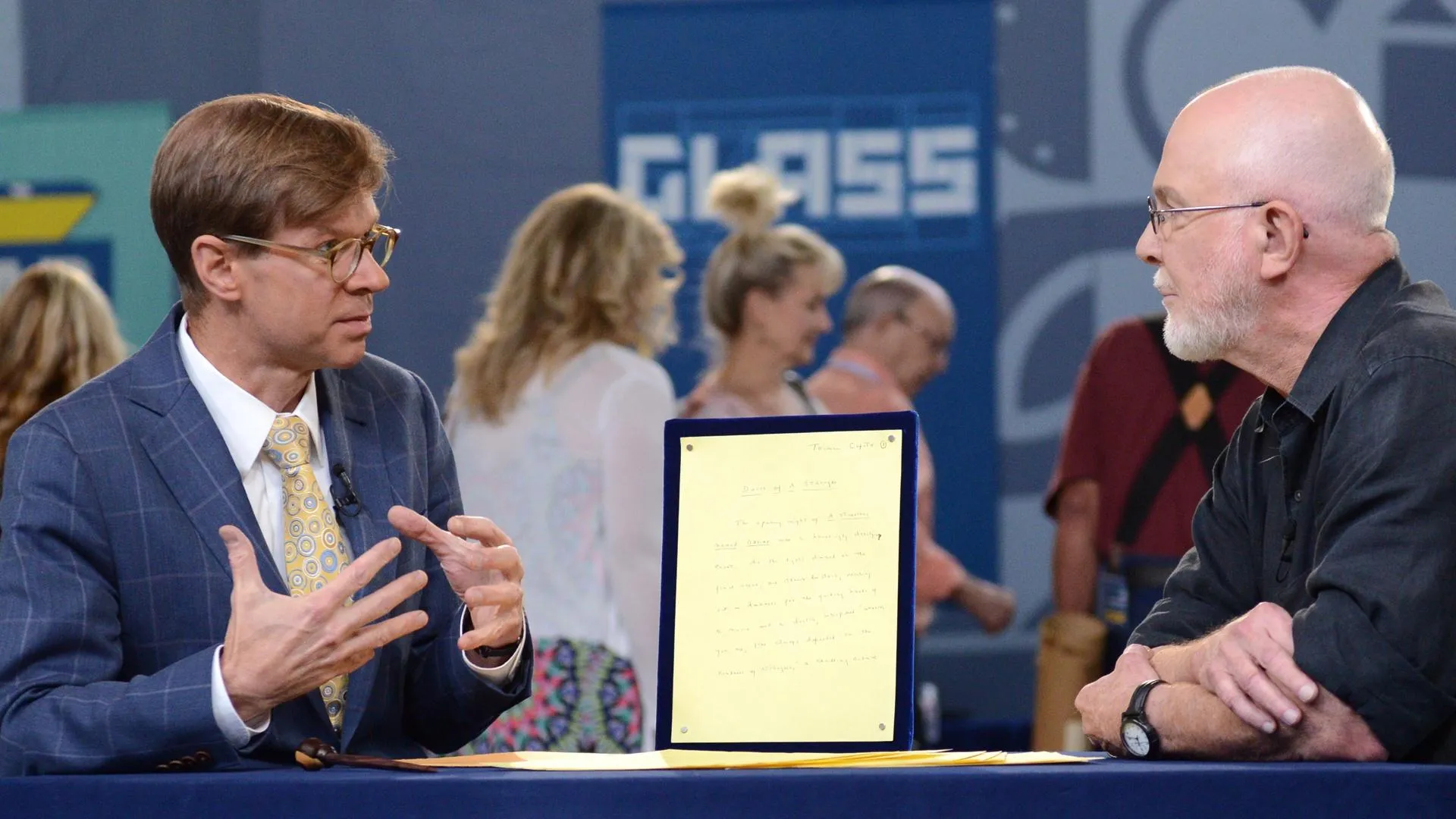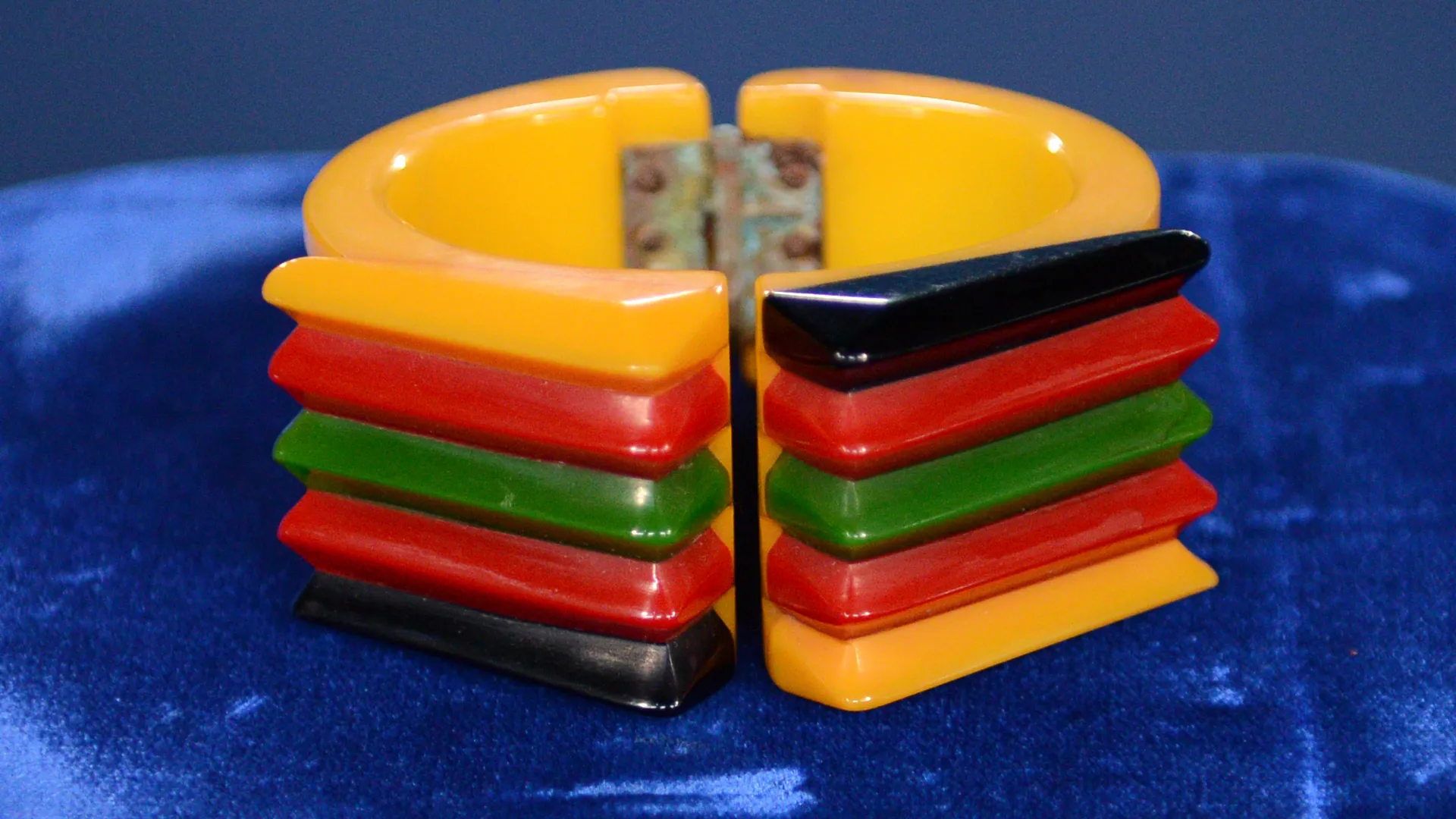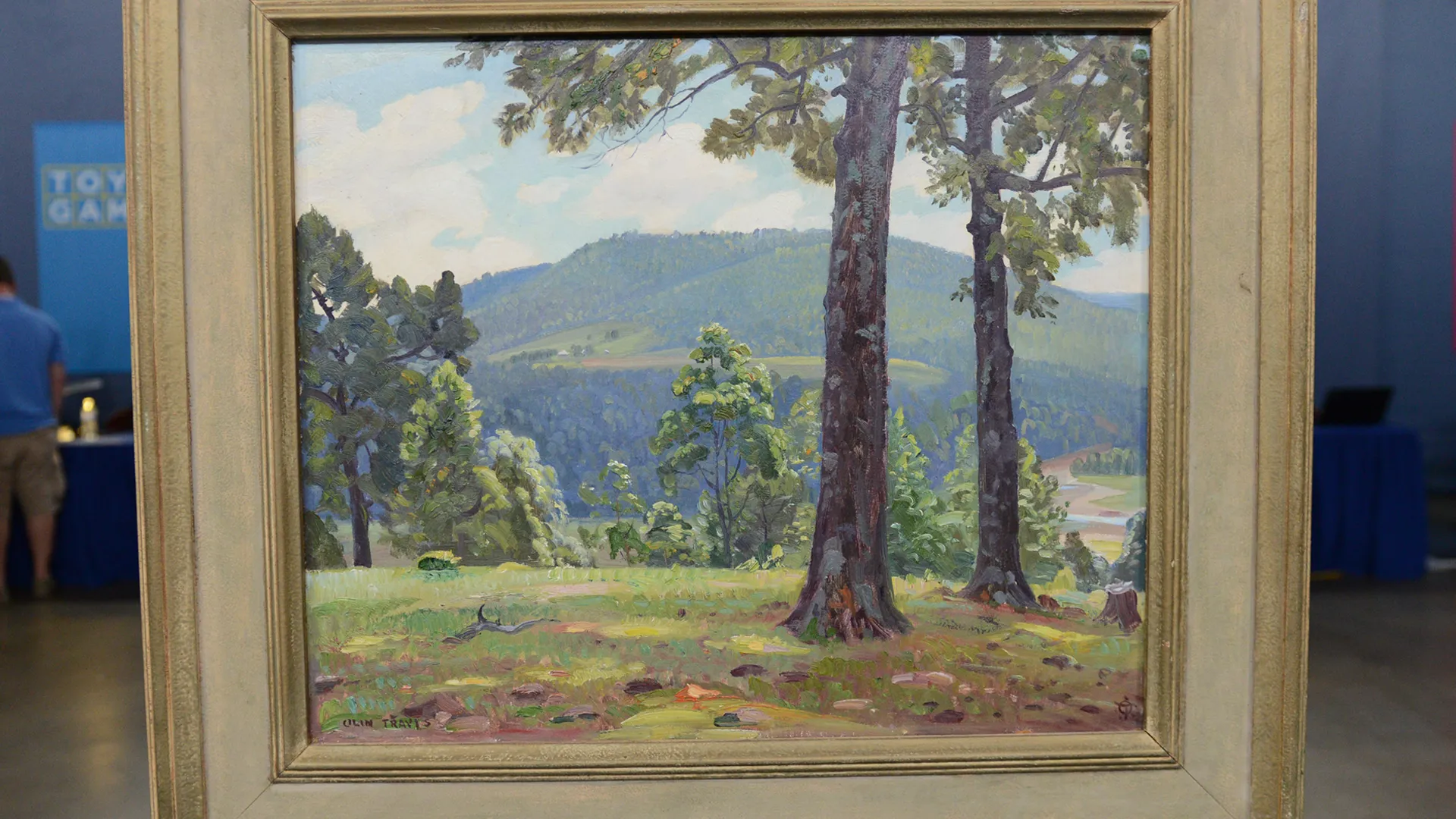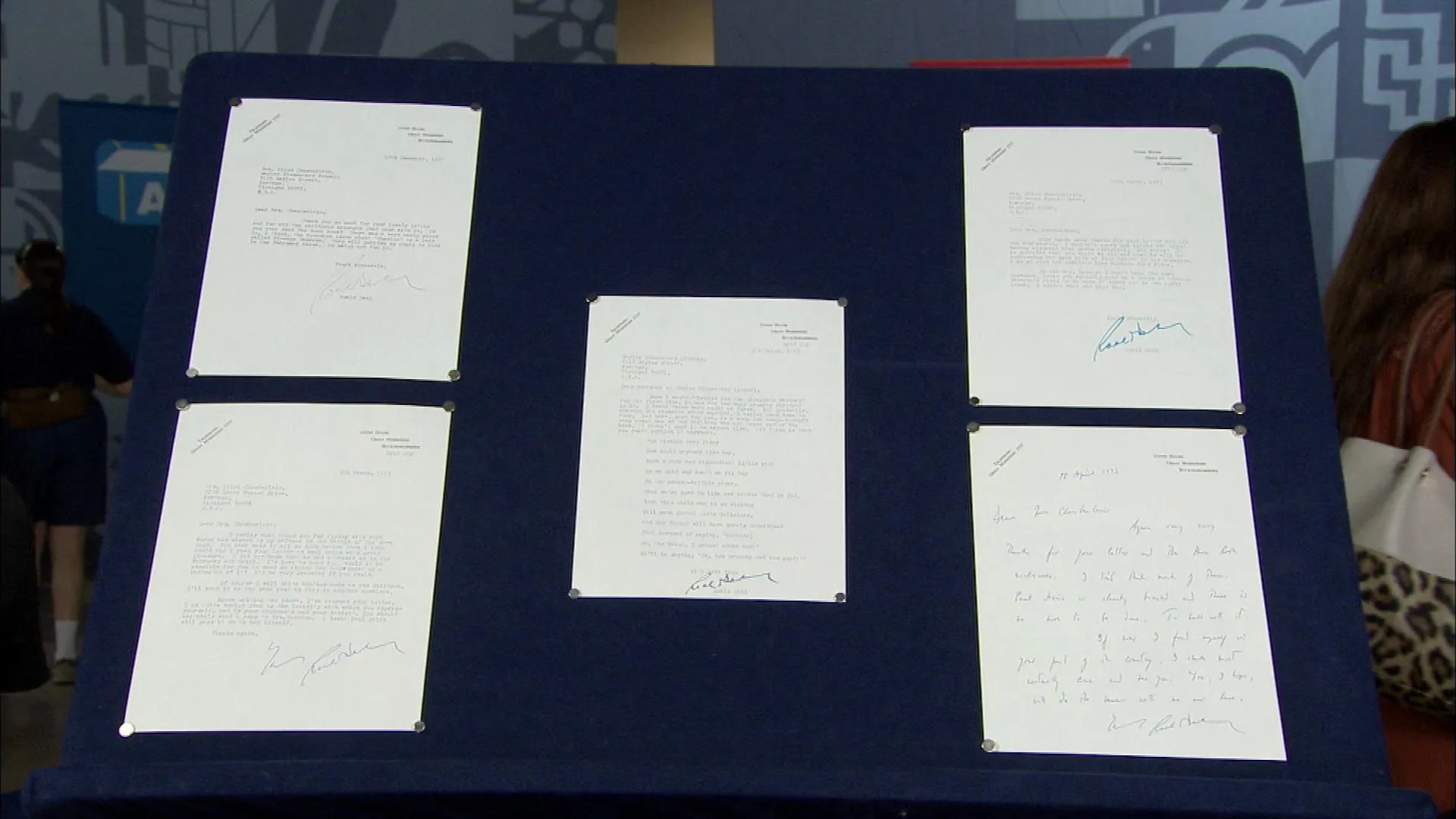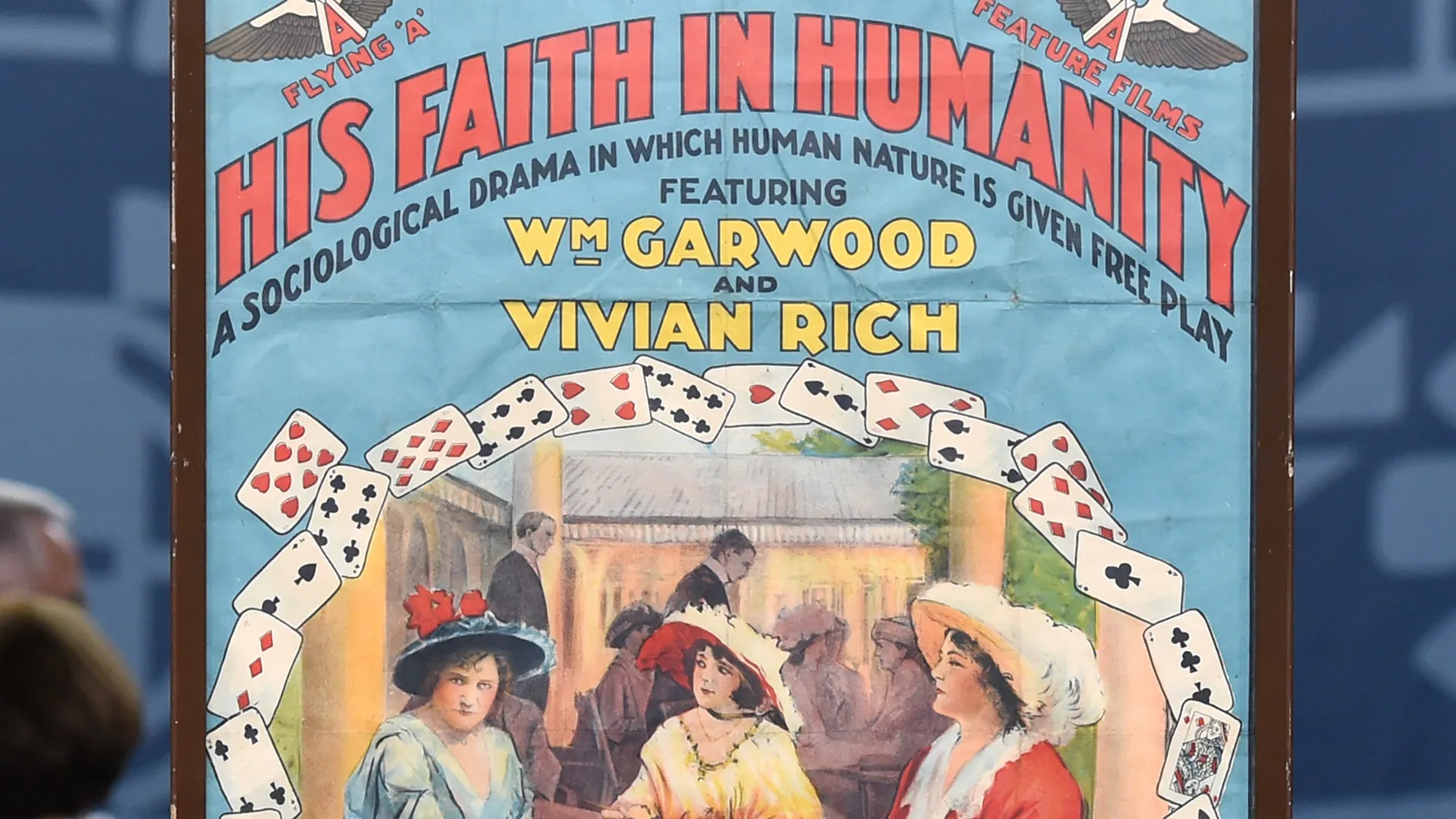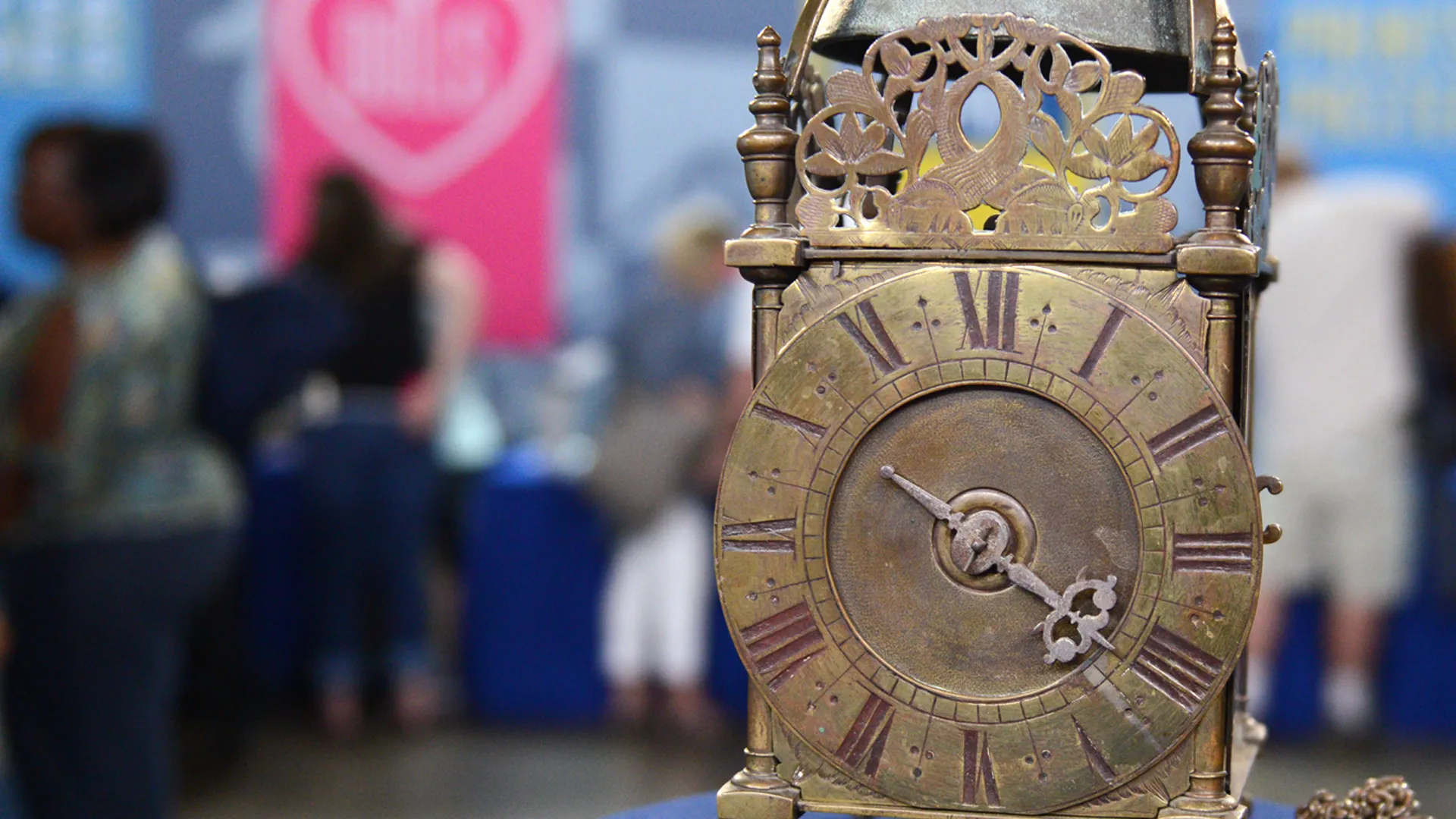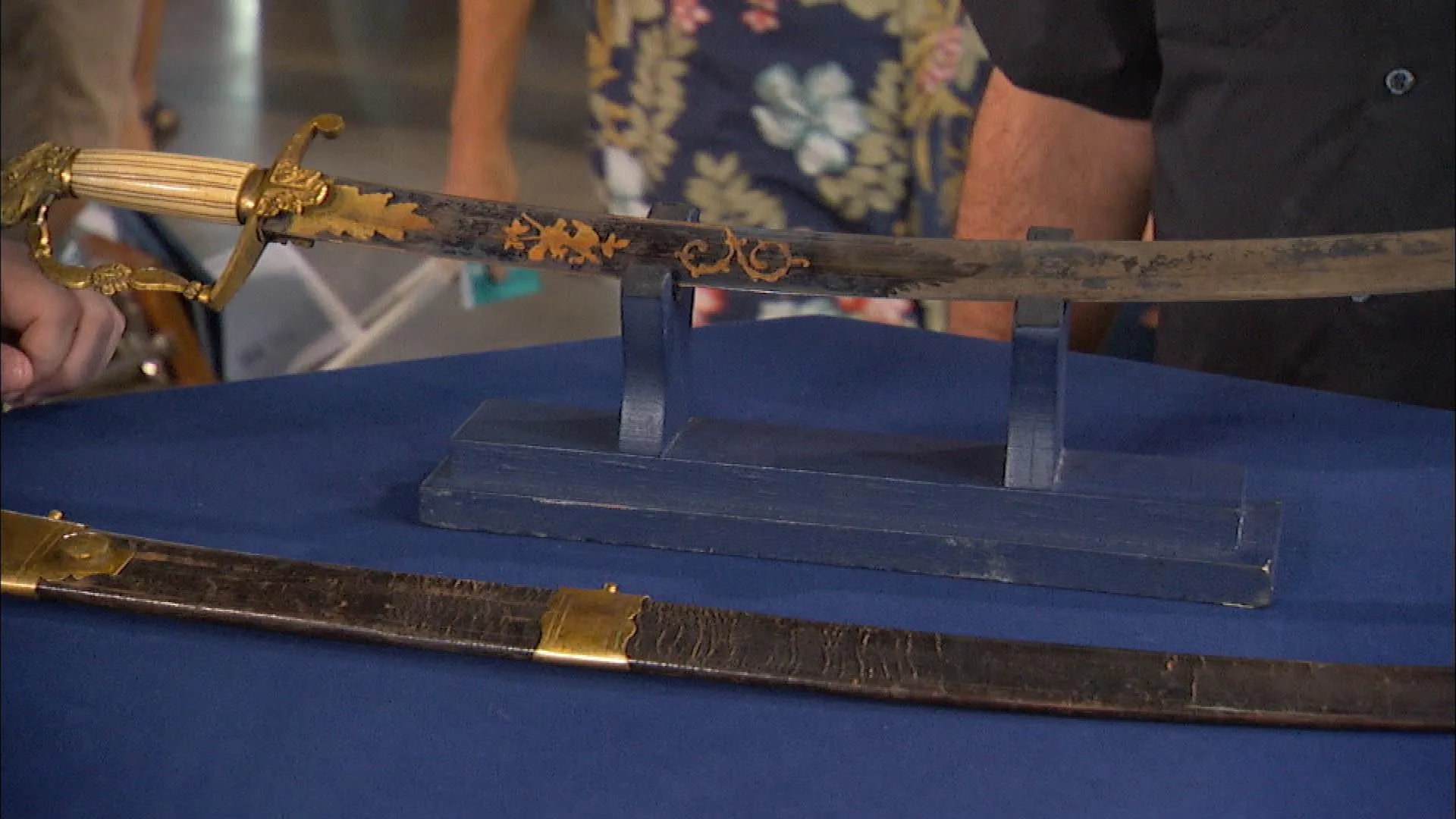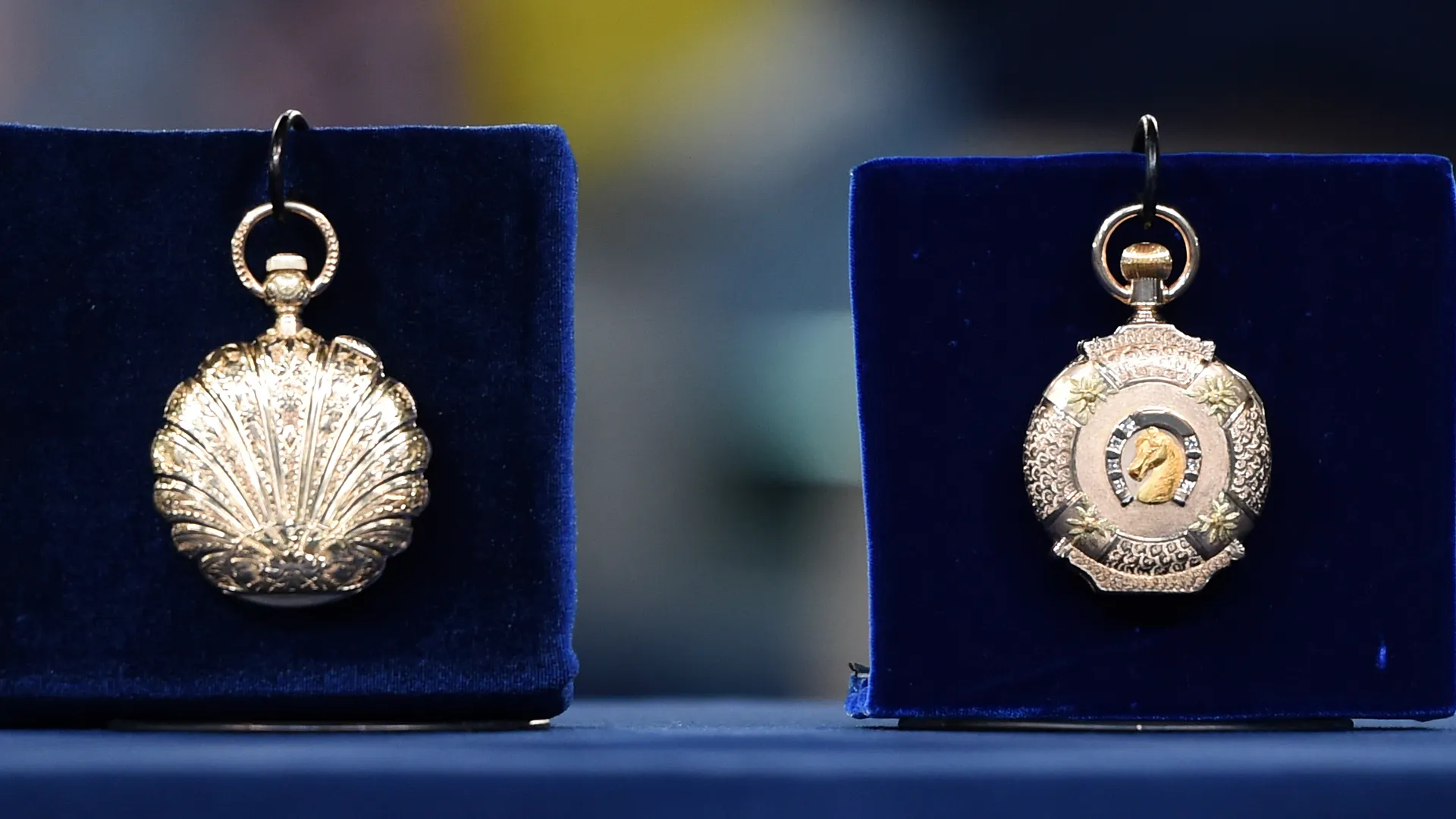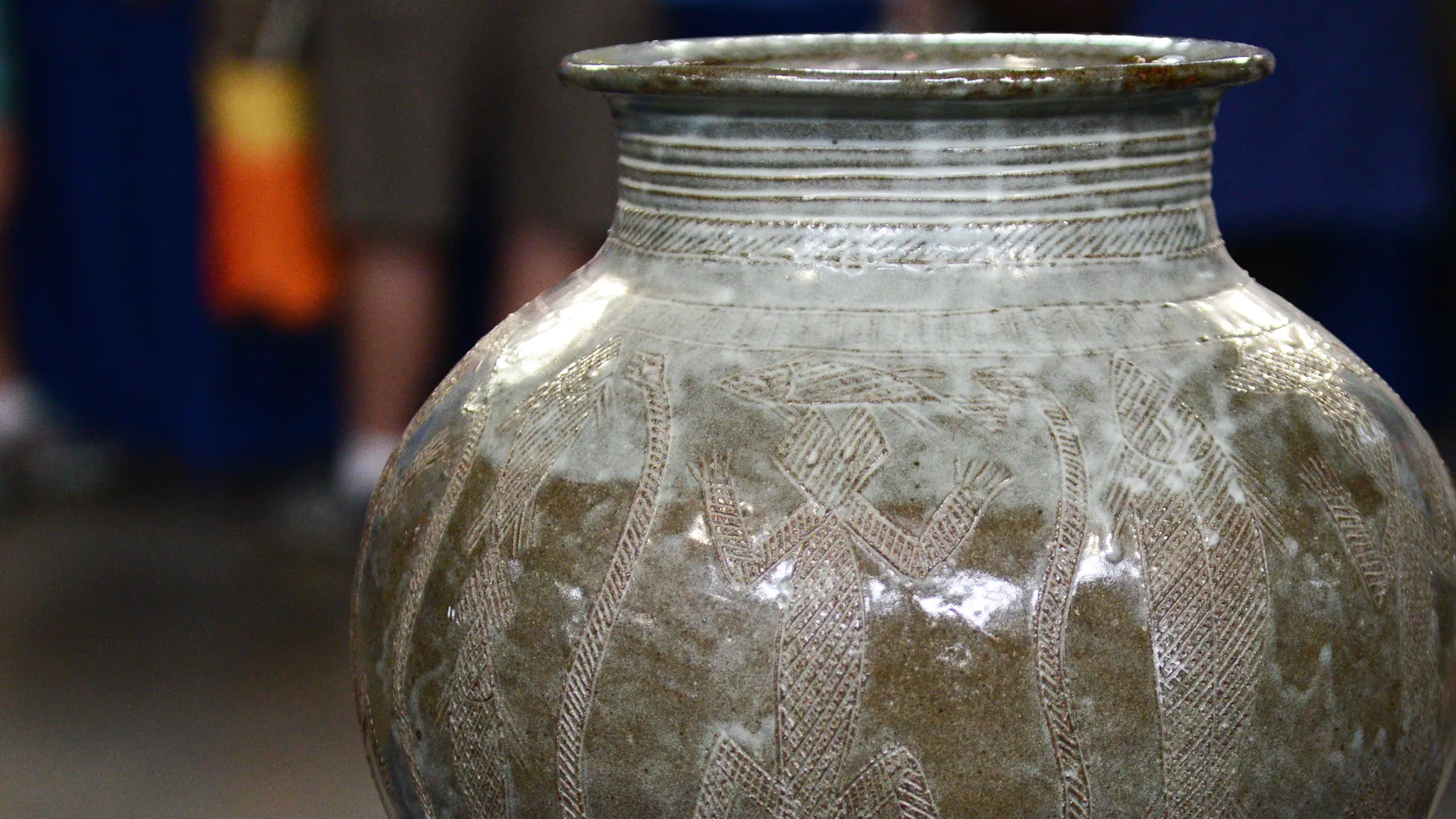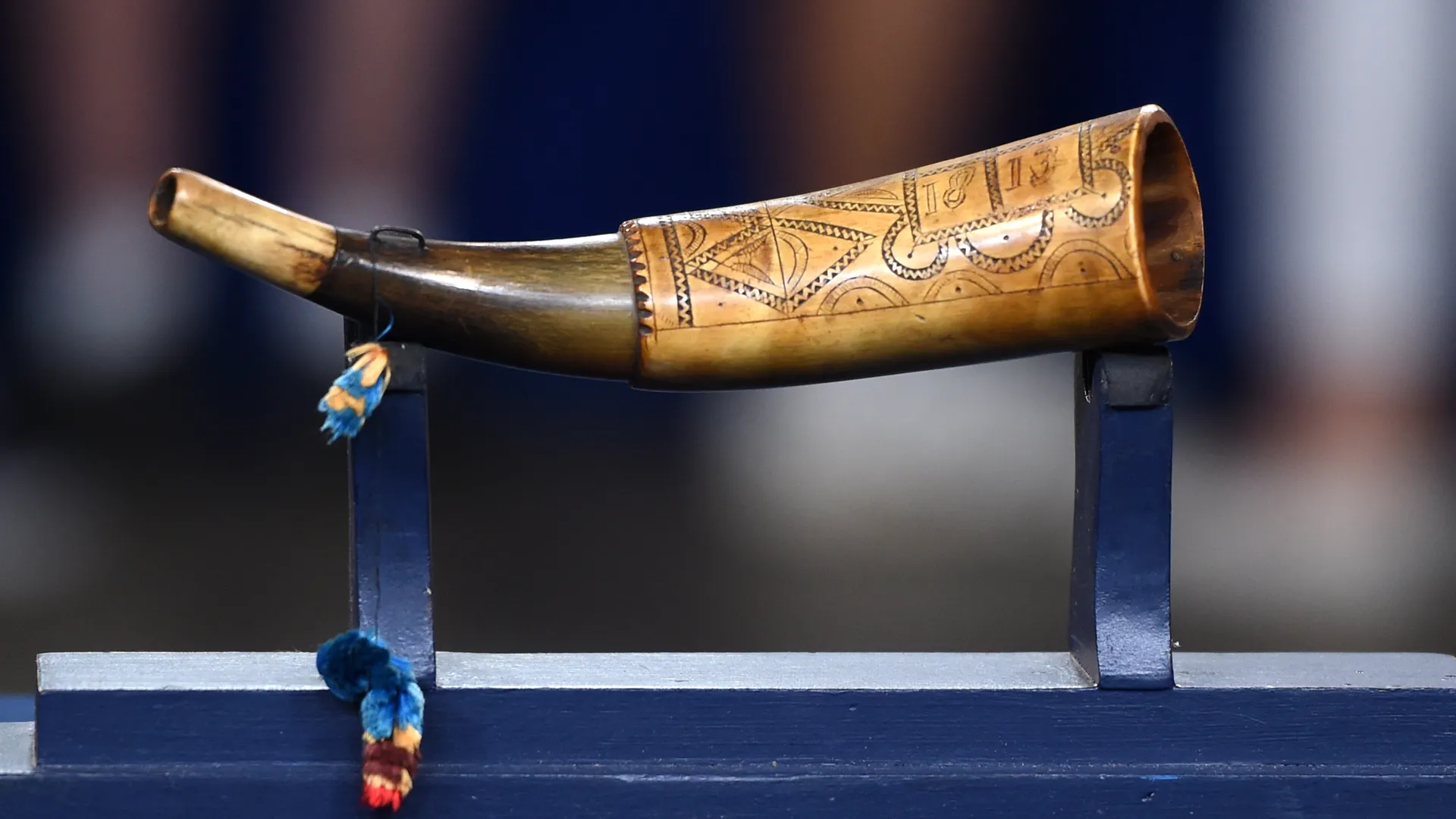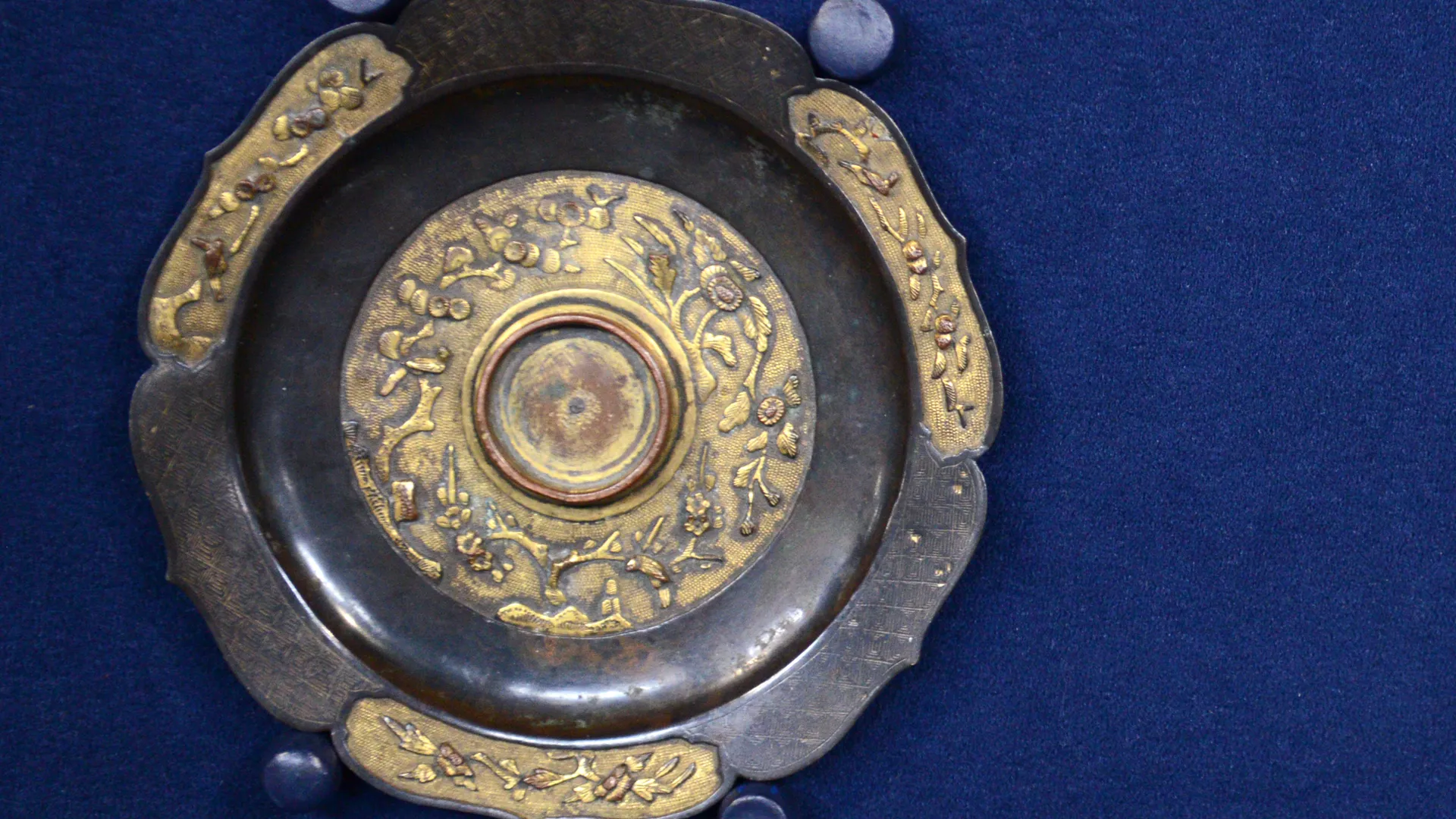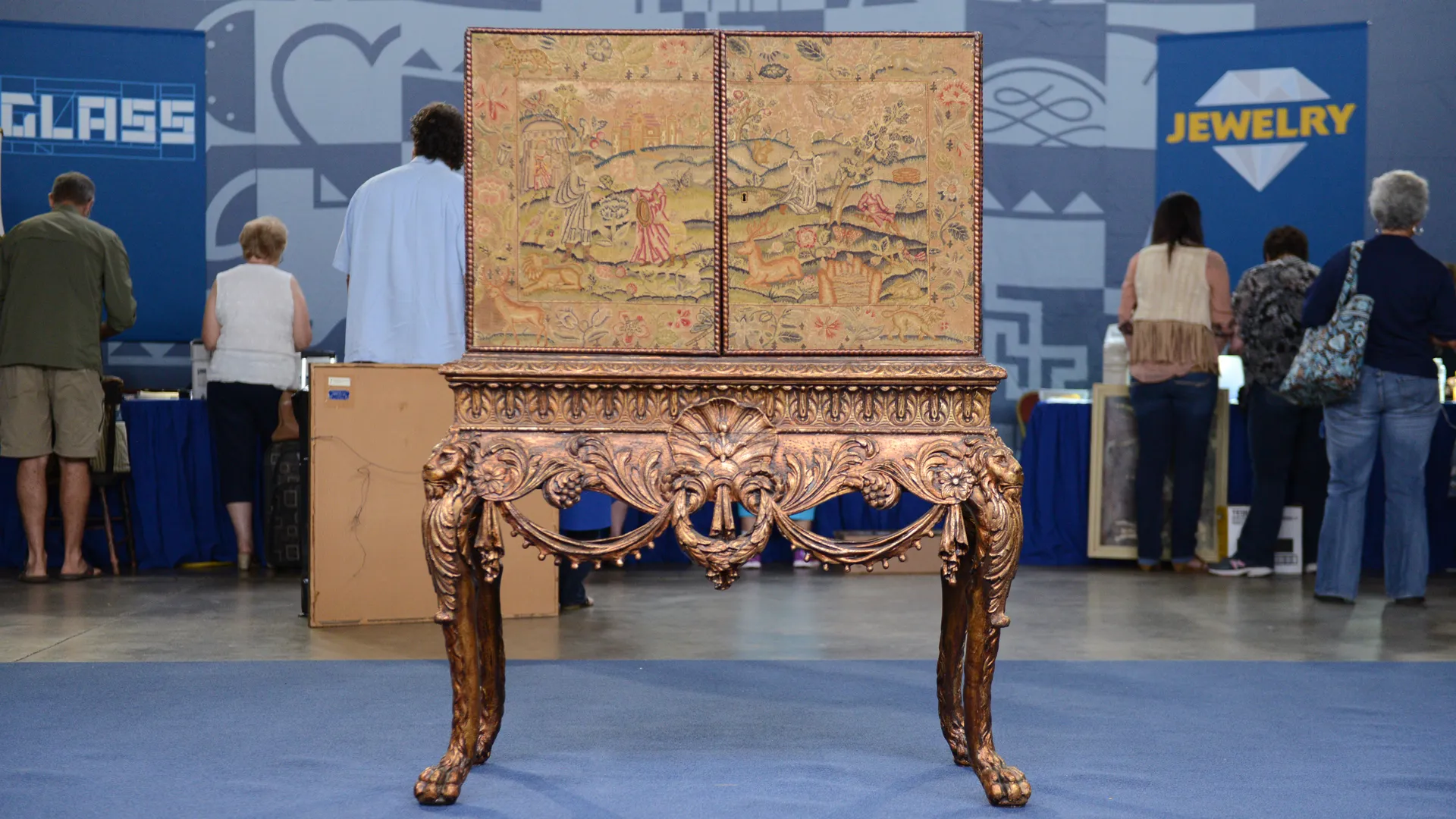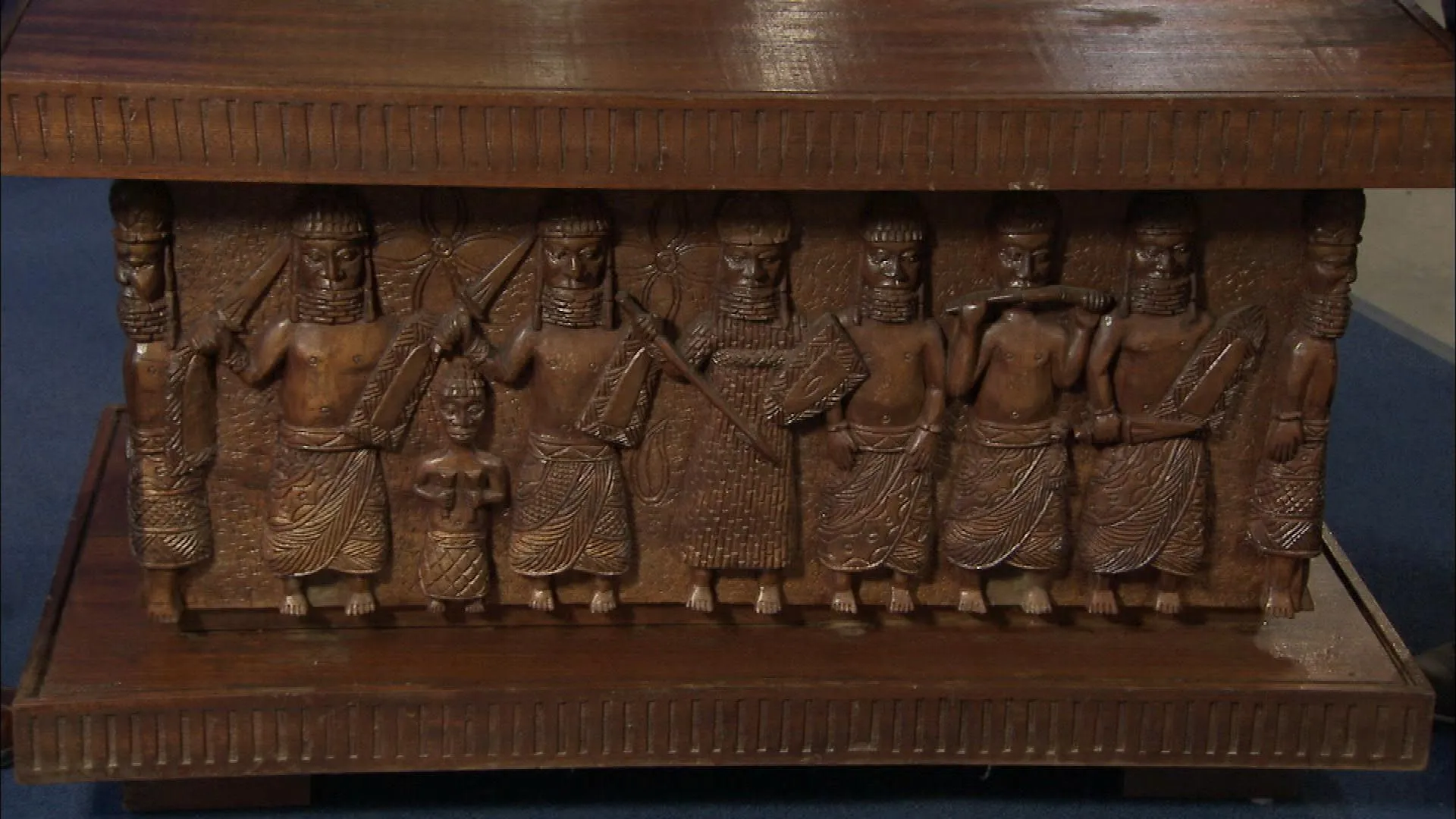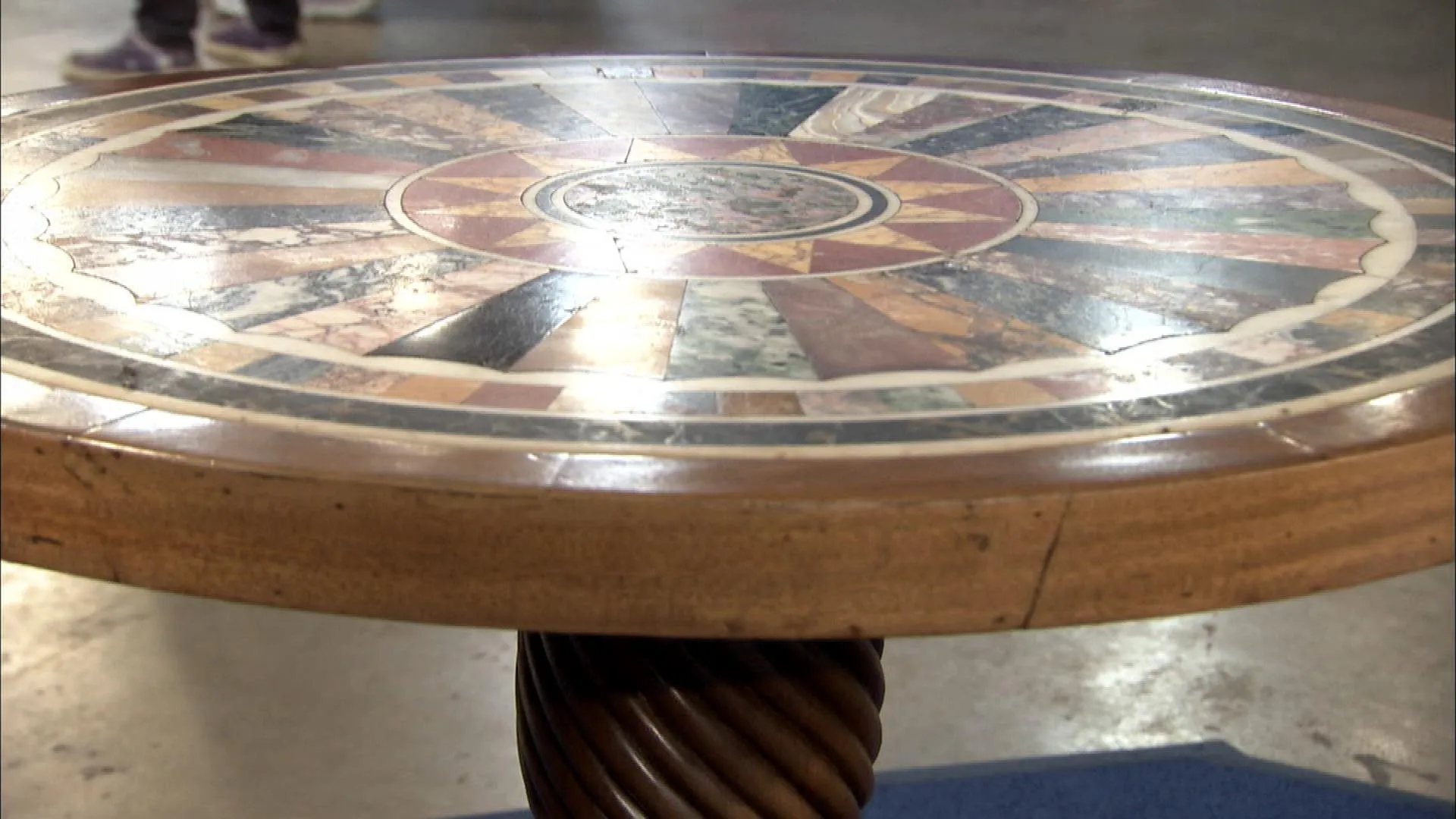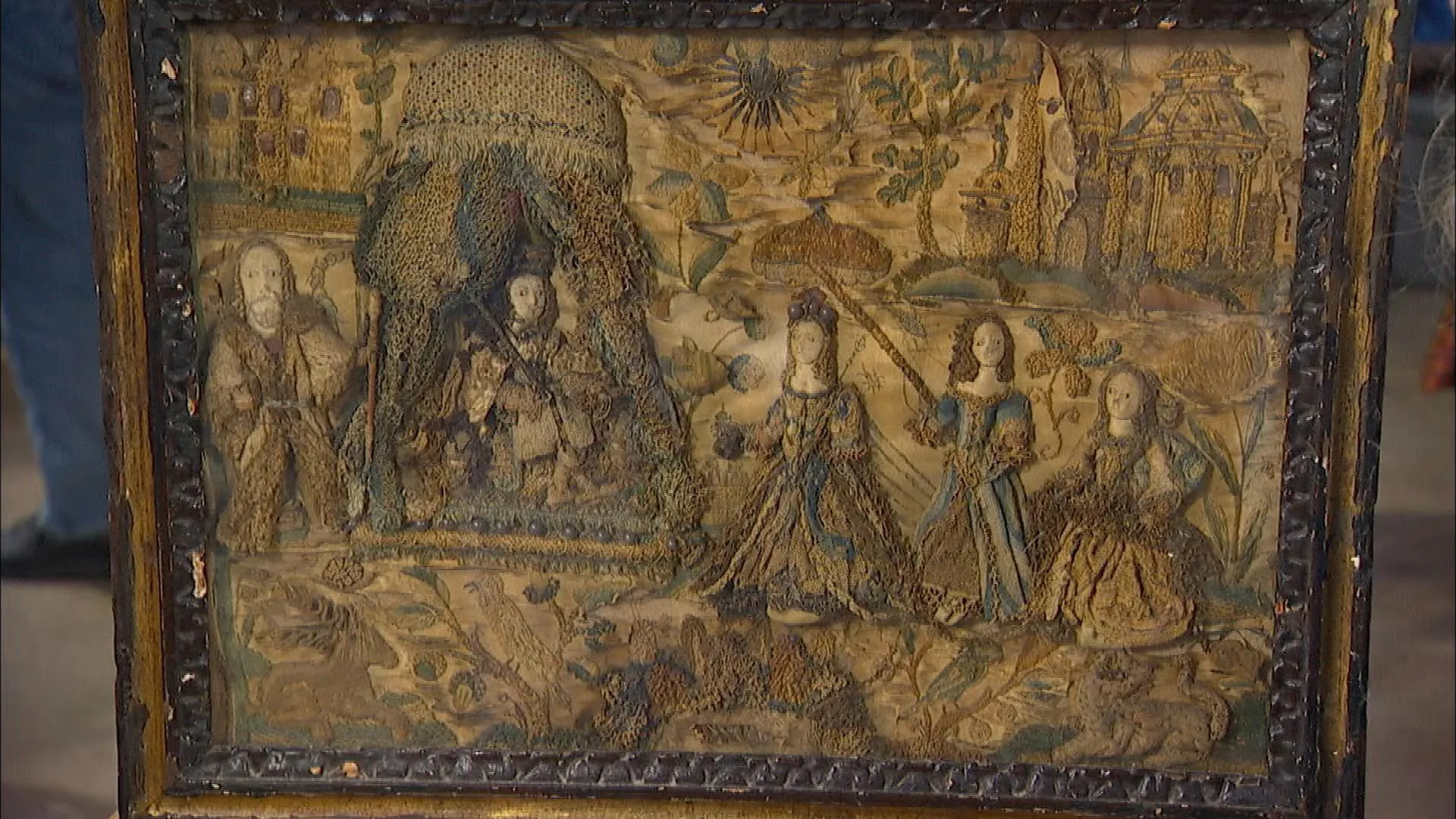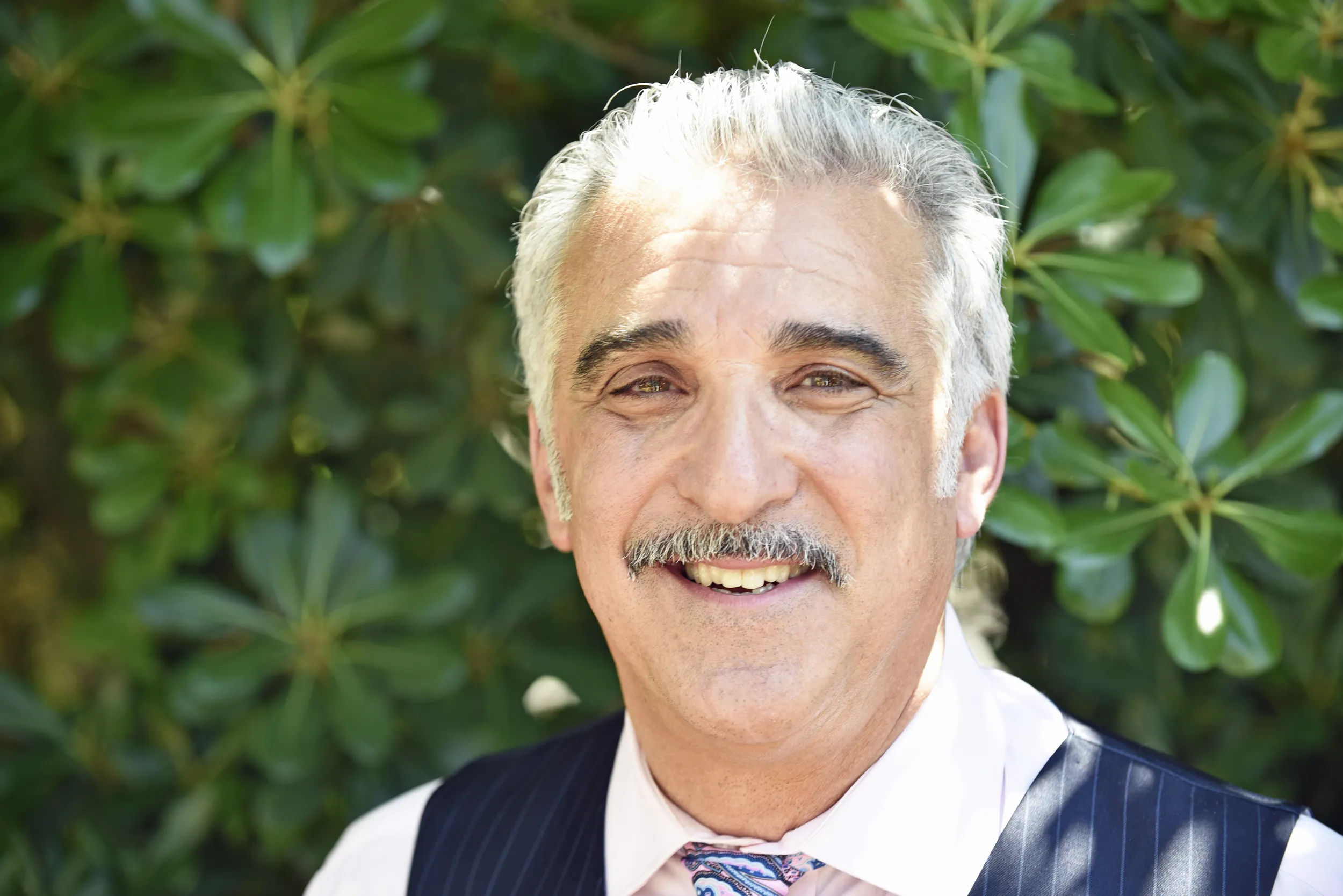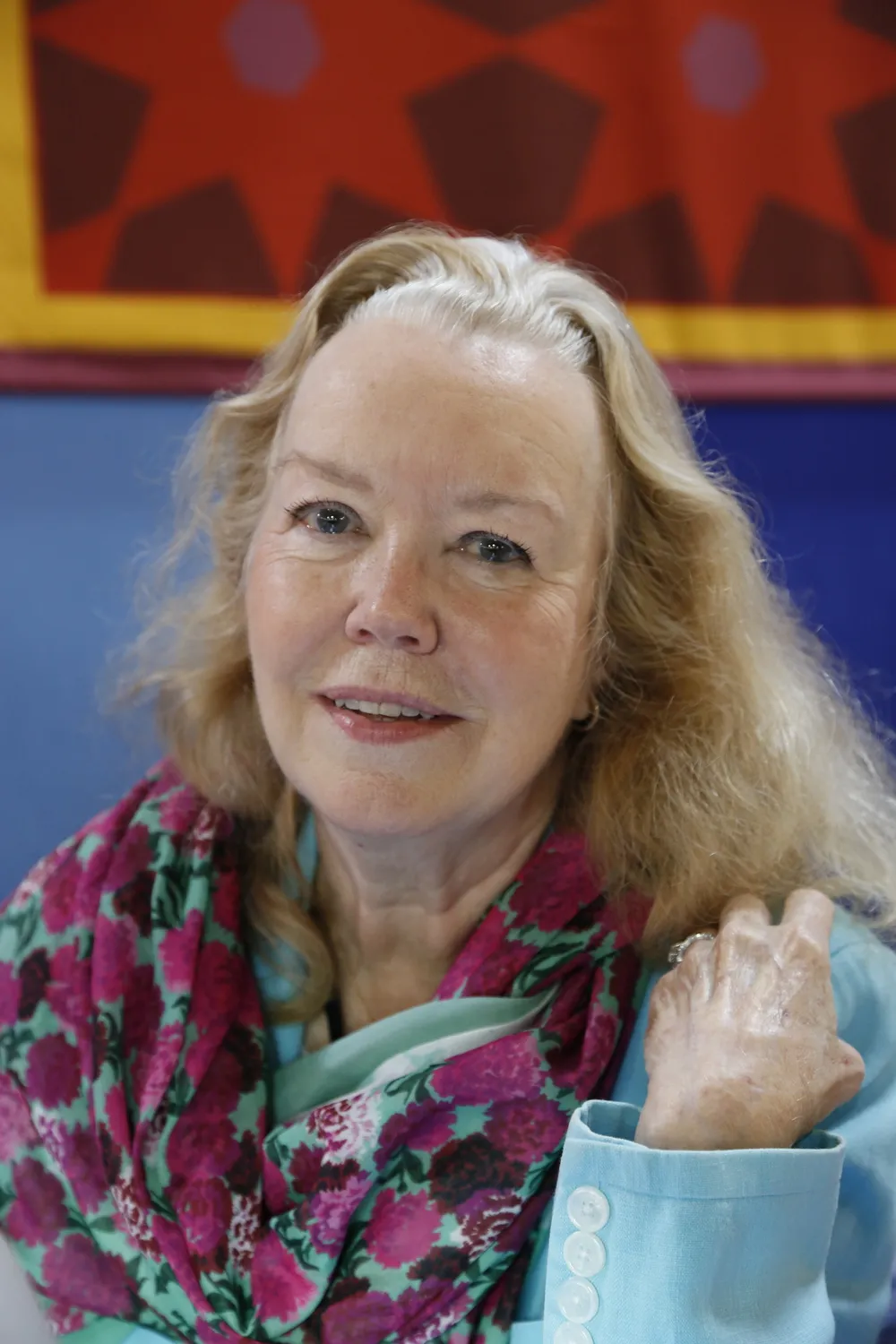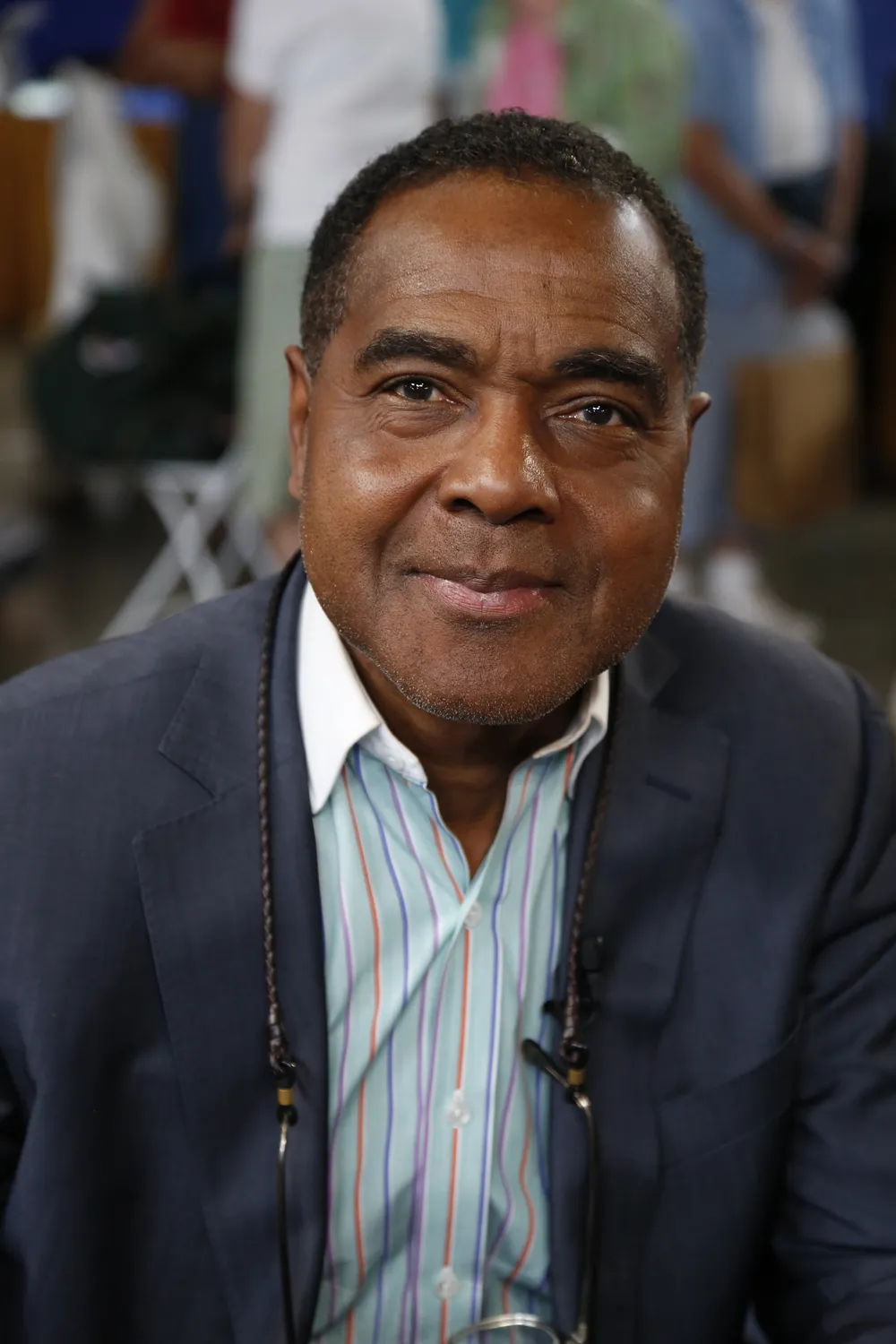HOST: Antiques Roadshow hit the capital city of Arkansas-- Little Rock.
APPRAISER: Most people would probably look at it and say, "Oh, heck, she bought a bracelet for $500 made out of plastic."
GUEST: I'm a little cuckoo that way.
(laughs)
GUEST: Wow, that's fantastic!
HOST: Antiques Roadshow was excited for our first visit to Little Rock. The city's name came from 18th-century French explorers who called the small rock formation on the south bank of the Arkansas River "Le Petit Rocher." Art, antiques, and collectables large and small have arrived at Roadshow today. Take a look.
APPRAISER: You brought in a bracelet.
GUEST: Yes, it's a piece of Bakelite bracelet.
APPRAISER: Where did you buy it?
GUEST: I bought it offline.
APPRAISER: And how much did you pay for it?
GUEST: About $500.
APPRAISER: That's a lot of money to pay for a bracelet.
GUEST: It is, it's a lot. I saw it and I thought it was really pretty.
APPRAISER: I mean, you say Bakelite, most people wouldn't know, and they would probably look at it and say…
GUEST: Right
APPRAISER: "Oh, heck, she bought a bracelet for $500 made out of plastic."
GUEST: Exactly!
APPRAISER: Right? right.
GUEST: I'm a little cuckoo that way.
(laughs)
APPRAISER: Bakelite was developed for industrial purposes back in 1907 by Leo Baekeland. They used it for things like the old kitchen utensils our grandparents would have, like the mixer with the red handle.
GUEST: Oh, yes.
APPRAISER: That would be Bakelite. While the material was invented by Leo Baekeland, we really don't know who made this bracelet. There was a lot of manufacturers in the business of making Bakelite. Jewelry people gravitated to it because it wasn't made like traditional plastic that was injection molded; it was carved from stock pieces. The makeup of it, it was a chemical makeup of phenol and formaldehyde. But because they could carve it, they could cut things like these triangular sections and then they could polish them. And then it also was extremely carve-able. You can see on the edges those little divots put in there. It came in many, many different colors. The colors had all these great names, like Mississippi Mud.
GUEST: Oh, wow!
APPRAISER: This one's called Butterscotch. There was other ones called Salmon and Spinach. I mean, they're just great names. Now, they also came in a green and a red. The green one and the red one usually sell for more money than this Butterscotch one.
GUEST: All right.
APPRAISER: Most of these bracelets come out of that sweet spot, around 1920 to 1935. So it does have some age to it. Your bracelet is called the Philadelphia bracelet. It got that name from a show in the early 1980s in Philadelphia. It sold for quite a large amount of money, and everybody in the jewelry and Bakelite community was surprised, so everybody was saying, "Hey, did you see what that Philly bracelet sold for?" And that's how it got the name, Philadelphia bracelet. There was a period ten, 15 years ago, people knew they were valuable, and they started making what we in the trade called "fakelite."
GUEST: Uh-huh.
APPRAISER: Started making it out of plastic. There's a few ways to test Bakelite to make sure that it's correct, but this is absolutely Bakelite.
GUEST: Oh, cool.
APPRAISER: If this were to go up for auction today, this bracelet would bring $2,000 to $3,000.
GUEST: Oh my gosh, that is fantastic!
APPRAISER: I think it's fantastic, I really do.
GUEST: I really got my money's worth, didn't I?
APPRAISER: I'd say you did. I'd absolutely say you did.
GUEST: That is so cool!
GUEST: About six years ago, my aunt was dying of cancer, but she invited family members to come through her home and choose whatever they'd like to have. And she would say yes or no if that's what she wanted you to have. But I was immediately drawn to this painting, and Aunt Marge said, "Good eye." She said she knew the artist back in the '40s, Olin Travis. She wanted to help him out, so she gave him $75 plus $15 a month to do this painting for her. Then she became his client that way, and he invited her later to some of his various art shows-- for instance, the Dallas Museum. And she was very happy to see that he'd made it enough to be on display in a museum.
APPRAISER: So she paid in total...?
GUEST: $275. On the back, it says it's an Ozark hilltop, and he had fallen in love with someone from the Ozarks, so this was a special time in his life.
APPRAISER: Olin Travis was born and raised in Dallas, Texas. He went to the Chicago Art Institute School, graduated in 1914, and he became a teacher there. Eventually, by 1921, he moved back to Dallas and he did fall in love and marry a girl from the Ozarks in about 1923.
GUEST: Oh, okay.
APPRAISER: Working in Dallas, he decided to open a summer art school and created an art colony in the Ozarks in about 1926.
GUEST: Oh, I didn't know that.
APPRAISER: It's a really beautiful painting, and especially because it is the Ozarks, we're here in Arkansas. The painting is oil on Masonite. He used the smooth side of the Masonite rather than the grainy side. Masonite came into use by artists in the 1930s even though it was invented a little bit earlier. The date of 1947 makes sense.
GUEST: I see.
APPRAISER: It's signed in the lower left, and in the lower right, there's a little marking. And you said that you didn't know what that was.
GUEST: Yeah, it looked like a little turtle to me.
APPRAISER: It's his initials, "O.T."
GUEST: Oh, well, there you go.
APPRAISER: So what this picture has is the trifecta. It's got perfect provenance; it's in excellent condition in its original frame; and it's a really good subject matter for the artist. Most of the artist's market is in Dallas, Texas, because that's where he's known and he's the native son. But I love the Arkansas subject matter, the great impasto, and the value is about $10,000 for insurance purposes.
GUEST: I did not expect that! Whoa! Holy cow! That takes my breath away. Good Lord.
APPRAISER: She was right, you do have a good eye.
(laughs)
GUEST: Wow. Where's my chair?
APPRAISER: What did you guess that it might be worth?
GUEST: I thought maybe $1,500, maybe.
GUEST: It is a napkin dispenser, and it has a penny for your fortune.
GUEST: That's some real stuff.
GUEST: I hope-- I don't know. (laughs)
GUEST: 45 years ago, when I was a children's librarian in Michigan, I initiated a program with the children of writing to famous authors that they liked. And I also wrote to those authors myself. And you are looking at some examples of responses that I received from, in this case, Roald Dahl, who is the author of Charlie and the Chocolate Factory, among other books.
APPRAISER: These letters were written between late 1972 and early 1973. Not long after Charlie and the Chocolate Factory had first been published.
GUEST: Yes.
APPRAISER: And the archive is basically talking about some reviews that he had gotten from a publisher.
GUEST: Yes, that's correct.
APPRAISER: Roald Dahl is one of the greatest and wickedest children authors out there.
GUEST (laughing): Yes, indeed.
APPRAISER: And just the text of some of these letters, kind of biting humor from time to time. And you can really feel his personal touch in many of these. And in one of them, he has an extra poem here about Miranda Mary Piker.
GUEST: Yes.
APPRAISER: Now, he took out a bunch of the children from the Charlie and the Chocolate Factory story. I guess the editors wanted to make a shorter book, so he removed several of the characters…
GUEST: Yes.
APPRAISER: And one of them was Mary Miranda Piker. And what you have written here is the Oompa Loompa song that'd be sung after every naughty child met their horrible demise.
GUEST: Yes.
APPRAISER: Now, there's a version of the Mary Piker poem in the archives that has a few different words. For example, rather than saying "crunchy," it says "tasty," and then a couple other variations out there. The version that eventually got published in 2005 by The London Times did include it as "how crunchy and how good."
(laughs)
APPRAISER: This particular archive, I would give it an auction estimate of $2,500 to $3,500.
GUEST: Whoa. That's amazing.
GUEST: It came from a field somewhere around Melville, Texas. There was a farm that was just sort of abandoned. I have a friend who goes out from time to time and does handy, you know, odd jobs and that sort of thing. And so he got the job of cleaning up and removing debris from the property, and in the process of doing that, by some miracle found this piece of pottery in pretty darn good condition.
APPRAISER: What do you know about the merchant here?
GUEST: Well, I began researching the name P.H. McGraw. He had this drug business in Natchez, Mississippi. He was involved with the Confederate Army, and it turns out that he was a little too old to be on active duty himself. What he did was he smuggled drugs across the Union lines.
APPRAISER: Really? That's an interesting story. We have here a name, "I. Thomas," and then a capacity mark of one, so that's a one-gallon jug. "I. Thomas" stands for Isaac Thomas, who was a potter in Maysville, Kentucky.
GUEST: Oh.
APPRAISER: Thomas was an early stoneware maker. He was making stoneware in Maysville in the 1830s up through the '50s and '60s.
GUEST: How old do you think this actually is?
APPRAISER: Well, I think it was probably made 1850, '55. He was obviously a very enterprising businessman. He was on the Ohio River, which is where Maysville is. He was sending salesmen down the Ohio, down to Natchez, taking orders for stoneware.
GUEST: Oh, interesting.
APPRAISER: And not only did he say, "Well, we'll put your name on it, Mr. McGraw," but “I'm going to make sure that my name is on this too, to advertise my business."
GUEST: Fantastic.
APPRAISER: Great example of marketing. The stoneware industry of Kentucky has not been very well studied. There are researchers now who are working studying early Maysville ceramic industry. This is precisely what their thesis was-- that these Maysville potters were directing their traffic down the river. So your friend found this while he was cleaning up a falling-down house in Texas.
GUEST: Yes.
APPRAISER: Did he give it to you or did you buy it from him?
GUEST: I bought it from him. I paid $30.
APPRAISER: $30.
GUEST: Well, we didn't know what it was or anything. So I don't know if I would ever sell it, but I would certainly make it right with him.
APPRAISER: I would think that a good auction estimate would be $1,000 to $1,500.
GUEST: Wow, that's fantastic. That's amazing.
GUEST: It's been in the house in our family as long as I can remember. My dad was an architect, so we're pretty sure he bought it early on. And I was the oldest, so I think I got first dibs on it.
APPRAISER: The chair is really exciting. It was designed by Charles and Ray Eames, a fantastic design duo of the 20th century. The postwar American period has become known as mid-century modern. And this chair more than anything else embodies that entire period. Herman Miller, the company that produced these, probably made hundreds of thousands of these chairs in various combinations. The top is a molded fiberglass shell, and this shell was interchangeable with different bases. And one of the rarest versions of those bases is the rocking chair base.
GUEST: Oh.
APPRAISER: It was originally conceived as a chair that could be used indoors or outdoors, and it very quickly became used by mothers and expecting mothers. About 20 years after the production started, it became really known as a nursing rocking chair, and Herman Miller stopped selling them and only started giving them away to expecting mothers that were working at Herman Miller.
GUEST: Oh, wow.
APPRAISER: Charles Eames was a great designer but he was even a better redesigner. There are some designers who would design something and leave it alone. Charles Eames never left well enough alone. He had to get back in there and change it. I'll show you some of the elements here. These rubber shock mounts were designed to have the seat and the base have a little bit more give when you sat in it. They've kind of turned rock hard over the years. Within a short period of time, those were redesigned smaller because they realized they didn't need so much surface area. The shell itself was originally designed with a rope embedded into the edge, and you can see the rope showing through the fiberglass side. The wood rockers were redesigned to be a little bit beefier to take a little bit more stress. So the next version was a little bit squarer and a little bit taller. But of all the pieces, the most interesting piece that was redesigned is this metal base. The metal base, which was designed in conjunction with the engineering department at UCLA in Los Angeles…
GUEST: Wow.
APPRAISER: …is really a design study of doing the most with the least. So it has this wonderful X-frame structure that gives it all of this engineering strength. These particular wires here that cross right in the middle of the chair, when you rock back and you put your ankles underneath and when you rock forward, it can hurt your ankles. I've seen thousands of these, and I've only seen three with this cross that's crossing right here. Because within months, they redesigned it where this cross actually crossed farther up here, next to the stretcher. The chair was designed between 1948 and 1950, and it was released in June of 1950. By October of 1950, they announced that they were now selling it in colors because they were infusing color into the shell. So we know that this chair was produced after October of 1950. Have you ever had any work done to the chair or has the family ever had any work done to the chair?
GUEST: There was one of the struts that I think was loose and my brother had contacted a friend who was a welder, but said, "Be very careful." And then he said after it got done, he was not even sure which one it was. He thought he did a good job.
APPRAISER: He did a very good job, but he didn't do a good enough job to fool me.
GUEST: Oh.
APPRAISER: I can tell you exactly which weld it is. It's actually this weld right here.
GUEST: Okay.
APPRAISER: You can see tiny little welding solder marks. And you can't see those anywhere else because all of these others were done with a slightly different technique. Also, at some point, these runners have been refinished. This has a dark stain on it that was not factory original. Over the years, the bottom has worn down and you can see that this is the color that these wood elements should be. So because of that one little tiny weld, even though it was done very sensitively, and because of the finish, it puts it in a category of a lower price range. However, it's still pretty impressive for a mass-produced chair. Do you have any idea what it might be worth?
GUEST: Maybe $1,000, $1,200? I don't know.
APPRAISER: Now, this is not in great condition, but it is rare. Even in this condition, I would put the value of this example at $1,500 at auction.
GUEST: Okay.
APPRAISER: Now, if it had the original finish and it had survived without being rewelded, conservatively, I would say $3,000 to $4,000 for an example that really proves to us that this was essentially a first edition. I just love this example. I just want to hug it.
(laughs)
GUEST: Wait, let me get my camera.
GUEST: Antiques Roadshow!
GUEST: This we purchased in Wisconsin, and I really don't know much about it.
GUEST: I brought a painting. It's my mom's, it's been in our house forever. A friend of hers, his grandfather was a doctor, and so sometimes people couldn't pay and I guess they gave him art. You know, the bartering system. And the grandmother took a liking to my mom, and so he gave her some of her paintings. I really don't know much about it, but it's one of my favorite paintings that she has.
APPRAISER: Well, the artist is Chang Yu Sanyu, and he mostly is known by just Sanyu. He was a Chinese- French artist. He was born in China. His family owned one of the biggest silk weaving mills there. And they were so wealthy that his brother who ran the mill, who was actually 37 years older than him, really took a liking to him, saw that he had a talent for art and basically paid for him to stay home and learn how to draw, paint, and do calligraphy. And in 1921, he went to France, and he was really enamored by the exotic world of life drawing from models. And so he put out about 2,000 of these drawings of female nudes, all done from life right there with the model right in front of him.
GUEST: And in France?
APPRAISER: While he was in France. And he did almost all of these with Chinese ink and brush, which is the same way that he did calligraphy. So there's a real fluidity to his work. He was able oftentimes to capture these figures in just a few brushstrokes. This one's really special because it is that ink on paper, but it also has the addition of the red pigment, which is a watercolor. In an auction today, an estimate for this drawing would be $50,000 to $75,000.
GUEST: Wow. Okay, great, that's great. My mom will be really happy to hear that.
GUEST: I purchased it at a local flea market. It's from a 1914 silent film. I just loved the graphics on it, I loved the flying A. I actually collect old signs and advertising, and it reminds me of Flying A Gasoline. I don't think it has anything to do with it, but I love the graphics on it.
APPRAISER: And how much did you pay for it?
GUEST: $500.
APPRAISER: And do you have any other posters in your collection?
GUEST: This is the only poster.
APPRAISER: So you've never owned a poster before, you saw this at a flea market, it was $500, and something about it reminded you of gasoline, so you bought it.
GUEST: Plus the beautiful women on it.
APPRAISER: Fair enough.
(laughs)
APPRAISER: And how do you know it's from 1914?
GUEST: Did a little research on the internet. And I could find some information, but I couldn't find the exact poster.
APPRAISER: Did you find out anything else about it?
GUEST: Not much. It listed the actors and actresses.
APPRAISER: Yes, it is a movie poster from 1914, and it's one of these movies that has been lost to time. So if we wanted to watch it now, we couldn't. As you said, there's a record of the director, there's a record of the actors, but that's it. Now, in the world of movie posters, what makes a poster valuable are the fame and the renown of the actors and the director. I'll point out on this poster, it doesn't even name who the director is. But the poster really is a great image, and it has a very interesting message: "A sociological drama in which human nature is given free play." It sounds a little bit like a temperance movie about anti-drinking, but in fact, it's not. And if we read at the bottom, "Her losses at bridge cause many anxious moments." So we can imagine that here's a woman who's losing a lot at cards and is getting upset, and what follows.
GUEST: She looks like it.
APPRAISER: And you were saying something about the coloring on it to me earlier?
GUEST: It almost looks like it's got a little bit of hand-drawn... The diamonds and the hearts don't look...
APPRAISER: You know, it's not hand-drawn, it's a lithograph, and where the ink is missing, that's because the register of the lithographic stone was slightly off. Now, what drew me to this poster was not so much that it was color coordinated with my outfit, although you might think that's the reason I chose it, but the fact that it is a playing card motif. And a lot of people collect playing cards, a lot of people collect images of gambling. This, as I mentioned, is a bridge poster. And when you looked it up, you weren't able to find any comparables. So we know that it's rare. So how do we price a very rare, lost movie poster for a not-so-famous movie? Any guesses what it might be worth?
GUEST: I'm hoping around $1,000.
APPRAISER: Well, I talked to some of my colleagues at the collectibles table and I said, "Maybe there's a big market for people who collect images of bridge." And in fact there's not. Bridge is sort of a game that's going out of vogue. Had it been a poker image, it would have an additional value. Even if it were a chess image, people collect chess imagery. It's our opinion that at auction, an estimate for this piece would be between $1,500 and $2,000.
GUEST: Okay. Well, I did good, then.
APPRAISER: If it were a poker image…
GUEST: Right.
APPRAISER: …The value would probably be double or triple.
GUEST: Man. I still love it.
GUEST: My dad was in World War II. He was a waist gunner on B-17s, decided to stay in the Air Force.
APPRAISER: Yes.
GUEST: And when I was little in the 1950s, we were stationed in London for about six years.
APPRAISER: Sure.
GUEST: And my mother and dad got really interested in the old things. I grew up being told to stand in the corner of an antique shop and not touch anything (laughs). And this is just something that's always been around. This was actually in a box in his garage.
APPRAISER: Yep.
GUEST: And I came through one day and I asked him what it was, and he said, "Oh, it's one of the early clocks." And I looked at it and he said, "If you want it, take it."
APPRAISER: It's what we call a lantern clock. They got their name because this sort of mimicked the shape of a lantern. Clock probably dates about 1670. Now, this was intended to be a wall clock. It was what we call the first domestic form of clock. This was the first clock that the average person of means could afford. Before that, just people of great wealth could afford a clock because clock making was in its infancy. This was the predecessor to the grandfather clock, and it's a handmade clock. This clock would've probably taken almost a month, a skilled workman's labor for a month, if you could imagine. It was not inexpensive. They were one-day clocks, at best. Some of them even only ran for 12 hours, so it had to be wound twice a day. But weight-driven. That's what would have hung off of the pulley and chain is the counterweight. The clock was made of brass and steel. The clock originally hung on the wall from this loop. And don't think of these as feet. They were sort of like a terminus, a finial. It's an English clock. Originally, this clock had what we call a balance wheel escapement positioned underneath the bell on the clock. This large round disc would rotate back and forth. It would beat one and a half seconds. A real unique sounding clock. Well, when the pendulum was introduced into clocks, most of these were converted. And this one was also converted to a pendulum because instead of being off maybe 15 minutes a day-- it's not very good timekeeping-- all of a sudden, it could keep time within a minute a day.
GUEST: Right.
APPRAISER: Now, going back to the front... You'll notice it was made with just one hand. Now, this one is not signed, and that's typically an indication that it was made outside of the guild system, which was in place at that time. Do you have any idea what your dad may have paid for the clock?
GUEST: I don't know exactly what he paid, but I doubt that he paid a whole lot.
APPRAISER: These clocks today retail usually sell in the $7,000 to $10,000 range.
GUEST (laughing): Is that right?
APPRAISER: Yeah, for a garage clock...
GUEST: So it was worth looking in the box.
APPRAISER: You chose wisely, too.
GUEST: No, that's great. Well, thank you very much, that's great.
APPRAISER: Well, thank you, Senator, for bringing it.
GUEST: Thank you so much for having me.
GUEST: I have a postcard that belonged to my husband's grandfather, and it is the autograph of Lou Gehrig.
APPRAISER: And what could you remember about receiving the postcard?
GUEST: It was in a scrapbook that his grandmother gave us, and you can see there's kind of glue marks on there. And I knew immediately I had to get it out of the paper because it had acid in the paper.
APPRAISER: So looking at this side of the postcard, we see the glue residue, and then we also see the postmark there.
GUEST: Right.
APPRAISER: From St. Petersburg, Florida, March 20, 1936.
GUEST: Yes.
APPRAISER: Let's take a look now at the signature. So first thing is, it is authentic.
GUEST: Okay.
APPRAISER: There's so many different factors in collecting autographs now. The collectors have insisted on not only authenticity, but also provenance. And with every autograph, there's a story. And what was great about the postcard is it tells us that this was mailed from spring training for the New York Yankees in 1936. Then there's the condition. The condition is excellent. It's a graphite signature that's really strong.
GUEST: Good.
APPRAISER: Then we look at Lou Gehrig in 1936. He was in the prime of his career. He was the league MVP, they won the World Series, he made the all-star team for the fourth straight year, he led the league in home runs with 49, with runs scored with 167. It was absolutely one of his best seasons of his career. Why this is important is because there's different levels of signatures. We have players who sign during their career. There's players who sign their whole lives. There's also signatures from players from an offseason. There's all those different factors that factor in. What's so great about this example is that 1936, being the prime of his career, makes it about as good as they get for a Gehrig signature. The other thing that I like is how you've taken the time to frame it, exposing the back. Anything else you know about Lou Gehrig?
GUEST: Of course Lou Gehrig's disease, ALS. Everybody associates that with him.
APPRAISER: Which he was diagnosed on June 19, 1939, on his birthday. Well, as we talked about it, great example from a great season in his career. So we would put an estimate on this, a retail value of $10,000.
(laughs)
GUEST: I'm stunned. I thought maybe $800 would be lucky. $10,000?
APPRAISER: Yup.
(gasps)
GUEST: I don't know whether it's Chinese or Japanese. I wish I did. I just have no idea. That's why I'm here.
GUEST: This belonged to a friend of the family. I know her husband served in World War II. When she passed, we received it.
APPRAISER: When you would guess this dates to?
GUEST: I was thinking basically about Second World War?
APPRAISER: Knock a century off and you're close.
GUEST (laughing): Okay.
APPRAISER: It's a Federal period sword. It comes from early American Republic period, around the War of 1812 and up into the 1840s.
GUEST: Oh, wow. These were very popular. They're called an eagle head sword. This is a particularly attractive example. He has a bone handle, an eagle head pommel, a single knuckle bow, and then all this is gilted brass. And you can see an awful lot of the gilt finish remaining on it. A lot of the ones that were very high end, they don't look high end anymore because this coal bluing that creates that beautiful frosted finish and the gilt on it, it doesn't survive very well. And that was one of the reasons why we were interested in your sword. Most of these in today's market aren't worth a whole lot of money. It's a sword that comes from a time period where the items might be rare, but the collector interest just isn't there. That being said, because of the fact that it's been kept in nice condition, the scabbard is still with it, it is orders of magnitude above where it would be if it was in normal condition. This sword would retail for between $1,200 and $1,500.
GUEST: Oh, wow.
GUEST: We were garage sale-ing in Kansas City, Kansas. We'd been out all day long, had been to the ATM once. We ran across this sale with this very elderly lady. The service was black, and it was sitting on a silver plate tray. I looked at it and then I thought, "No, I don't know anything about this." So we left. And I said, "I think we should go back." Between the two of us, we had $16, and she had $25 on this. And she said, "You can have it for $16."
APPRAISER: When did you go to this yard sale?
GUEST: It was about two years ago now.
APPRAISER: Did you have any idea what it was when you bought it?
GUEST: I thought it was silver, but it was so black. And the tray that it was on, I know it was silver-plate because I could see the copper.
APPRAISER: Mm-hmm.
GUEST: And I was afraid that's what this was. But I thought, you know, $16, we'd just take a chance.
APPRAISER: And out of curiosity, did you buy the tray?
GUEST: Yes, I still have the tray.
APPRAISER: And was that included in the $16?
GUEST: Oh, yeah.
APPRAISER: I mean, that shows that you are up on some silver knowledge that you could spot the copper on the tray.
GUEST: Yeah.
APPRAISER: And then with silver, when it tarnishes and gets really black, you do sort of have to take a flyer as to what it is. Maybe it's silver, maybe it's plate. If you look at it on the face of it, it all seems to match. But when you look at the marks, it's more of a mixed bag.
GUEST: Really?
APPRAISER: So what we've got is a three-piece set, and then two individual pieces.
GUEST: Really?
APPRAISER: Which isn't terribly uncommon with English silver in particular, which is what all of these pieces are-- English sterling.
GUEST: Oh, okay.
APPRAISER: All of the five pieces have proper English hallmarks. The three-piece set all have matching hallmarks for Sheffield, England. And the date letter dates them to 1904 to 1905. And they all have a matching maker's mark. It is for J. Richard Attenborough Company Limited. And then also made in Sheffield is this little guy. I call these hot water pots. There are some that might call it a hot milk pot, but my preference is as a hot water pot. And the marks on this little guy are also Sheffield, and he's 1903, so he's a tiny bit earlier. And he has different maker's marks. So even though it looks the same, it's different. And then the coffee pot, he is made in London-- again, different maker than the other pieces.
GUEST: Wow.
APPRAISER: And he's 1903. So it's not uncommon for English tea sets to have these different dates and makers. Sometimes you didn't have enough money to buy the whole set at once. What we're seeing here is sort of a restatement of a classic late Georgian, early Regency design, which was very trendy in this Edwardian period. The handles look like wood, and that's the intention. But in this period, they're using composition. Silver from this period with this look is fairly easy to acquire, so it's not rare in terms of its age or its style.
GUEST: Sure.
APPRAISER: But it is a lot of silver weight. So I think from your $16 investment, at auction, you're probably looking at $1,000 to $1,500 worth of silver from $16.
GUEST: Well, that's okay.
APPRAISER: That is okay. I want to shop at the tag sales you're going to.
GUEST: It just reaffirms that if you like something and the price is right, you just better buy it.
GUEST: These watches used to belong to my son-in-law. I inherited them from him, and he passed away about a year and a half ago. I didn't know a whole lot about them. I believe he got them from a guy in Ohio. He had been collecting pocket watches and case pocket knives for years. I think at one time, he probably had 500 watches.
APPRAISER: That's quite a collection. These are watches that were made by E. Howard and Company. Now, Edward Howard was a very important figure in American watchmaking. He was one of the founders of the great watch factories outside of Boston. And Howard watches are always very highly regarded. These are both beautiful examples of American gold work, but they're also industrial design at its very, very best. When you went to buy a watch back then-- and these date from perhaps the 1880s or so-- you could pick and choose a lot of the components of the watch. So these are Howard movements, but they're in very, very special cases. On the right here is a box hinge multicolored case. It's a typically American case. If we open up the watch itself and look at the dial, we can see that it's a very fancy painted dial. This is an extra feature that you would have in the watch. Not only that, the watch is decorated with diamonds, and is about as heavy as you would want a watch to carry. The same thing is true of this particular watch in a scallop shell case. If we open it up, we can see it's got a black dial, which is very, very rare. Now, the thing that sets these watches apart is not so much the fact that they're Howards. Howard has a number of very, very rare watches, which are made only in a few examples. These were actually made in the tens of thousands of examples. They're beautiful watches, they're quite desirable, collectors like them very much, but it's the cases that make these very, very special. Not only are the cases particularly heavy and well-decorated, but they're in beautiful mint condition. They're two of the very best American watch cases you're likely to run across. I would say that each of these watches, as a pre-sale auction estimate, should have an estimate of around $8,000 to $10,000.
GUEST: Each?
APPRAISER: Each. Which compares to an ordinary Howard that's worth perhaps $2,000 or $3,000.
GUEST: I know it's a Ladi Kwali pot from Abuja Pottery. I lived in Kaduna, Nigeria, northern Nigeria, from the mid to the late '70s.
APPRAISER: Okay.
GUEST: And I bought it there, I loved it. I like pottery and I loved all of the Nigerian pottery.
APPRAISER: What did you pay for it?
GUEST: 100 Naira.
APPRAISER: Which would translate as approximately...?
GUEST: Well, I don't know the exact exchange rate, but I would say $120, $125?
APPRAISER: Well, it's a Ladi Kwali pot, as you've mentioned. And she was born in 1925 in the village of Kwali in the Gwari region of northern Nigeria. And she grew up, like a lot of young African women, making pots-- for the water pots and things like that. She got this reputation of producing these very beautiful pots. And the Emir of Abuja had bought some and liked them very much. And at this time, there was a gentleman from England called Michael Cardew, who was a major studio potter, and he had recently been made pottery officer by the Nigerian government. He wanted to introduce an industrial side to making pottery, and he saw Ladi's work and he invited her to join his workshop. And she was a star. She was the only woman in the workshop, in fact, at the time. He then showed her how to work on a wheel, which she hadn't done before. Up until then, all the work had been made by hand and coiled and was fired by local vegetation that they found. In working on the coiled pots and then firing them at a higher temperature, she sort of introduced this new dynamic with African art, African pottery, from the regular pottery to the more industrial firing techniques, the higher... She became very famous, and in the '50s and '60s she achieved huge status in England. She was shown at the Barclay Galleries in England and was awarded a doctorate and an MBE for her services. She was known for doing this incised work on the pottery. And you can see all around here that there is various animals and fish and plants. And this is absolutely typical of her work. She fired a lot with these green glazes and with brown glazes as well. It's difficult to date her work, especially from this later period. They're all incised under the base. I can't tip it over; it's a very heavy pot, in fact.
GUEST: It is very heavy.
APPRAISER: She died in '84, I believe?
GUEST: 1984.
APPRAISER: So I think this work is probably made in the '70s sometime.
GUEST: Oh.
APPRAISER: I think a conservative estimate, a retail price for the work would be between $8,000 and $10,000. That’s good.
(laughs)
GUEST: That's wonderful!
APPRAISER: No, it's wonderful material.
GUEST: Really? I'm astounded. I am absolutely astounded.
APPRAISER: You paid pretty much exactly what it's worth.
GUEST:Oh, really?
APPRAISER: What did y'all pay for it?
GUEST: Ten dollars.
APPRAISER: How about $50 to $75?
GUEST: I was the operations manager at an office in Murfreesboro, Tennessee. We were remodeling and this was about to be thrown out, and I saved it from a dumpster.
APPRAISER: So you are a platter saver.
GUEST: I'm a dumpster diver.
APPRAISER: Dumpster diver, that's good. You thought that it might have been made in Scandinavia, I think you had said?
GUEST: I looked it up on the internet.
APPRAISER: It's actually made in England, and it's made in a region called Staffordshire sometime between 1840 and 1860. And what's wrong with this actually, if you look across the transfer print on the top, you can see that there's an overlay in that. There's some firing flaws to this as well. And in general, it's not superbly made. That's what's wrong with it. What's right with it is the fact that it's made by Ashworth. They made a lot of Staffordshire pottery, and this was made for the Russian market, not for the English market. And this is all about trade. It's a really unusual example. You just don't find this stuff out there very often. If this were, say, an English scene or an American scene, it would be worth about $50 or $75. At auction, I would see this bringing about $700 to $900.
GUEST: Wow.
APPRAISER: Not bad for a dumpster dive, huh?
GUEST: Serious dumpster diving here.
GUEST: This has been in my family for a number of generations. It was given to my great-great-great-grandfather, who came to this country from Ireland. He ended up settling in Indian territory, which was in Indiana then. He was an Indian scout in the Battle of Tippecanoe and also in the Battle of 1812. And then later on, he ended up in Georgia as an Indian peacemaker working with relocating the Indian chiefs and the Indians from Carolina and Florida. And he became friends with a Seminole Indian chief from Florida named Billy Bowlegs, who gave this to him. And it's been in our family ever since.
APPRAISER: Billy Bowlegs was the Seminole chief after Osceola. During the War of 1812, the Seminoles sided with the British to a great degree. The British really stirred up a lot of hostility against the Americans. They fought a war after that with the American Army, and then again in the 1840s fought another war against the American Army. At that time, the principal chief was Billy Bowlegs. His name was Halpuda Mikko in Muscogee. They were one of the Creek-speaking groups. And Seminole means "runaway" or "separatist" in the Muscogee language, and they were considered to be separated from the main part of the tribe when they moved into Florida. And Bowlegs was a holdout. He refused to go over the Trail of Tears when they went to Indian territory. He was also like an ambassador. So when you see these big books of portraits of the American Indian representatives to Washington, Bowlegs is in all of them, and his portrait appears frequently. He was a very, very important chief in the southeastern United States. Finally, after years of warfare, they convinced him to move to Indian territory, which is now Oklahoma, in the 1850s, the late 1850s. Halpuda Mikko, "halpuda" means alligator, "mikko" is just the Muscogee word for chief. So he was called the alligator chief. If you look at this horn, it's dated 1813, so I expect it was carved at the end of the War of 1812 with the British.
GUEST: Oh, okay.
APPRAISER: I suspect it was made by someone in the tribe. It's a great, great piece of American history. And I saw that this horn was actually published in a historical quarterly in the 1950s. It's got incredible documentation in your family. The history is just unbeatable. You can see the back side's plain, and all the carving's on the front.
GUEST: Right.
APPRAISER: And that's probably... it was made to show from that side and to hang off a strap.
GUEST: Oh, okay.
APPRAISER: It's very hard to know what something like this would bring if it came up for auction. The bottom's gone, which makes absolutely no difference at all, and it's been gone for probably 150 years. I think conservatively, because it's so historic and connected with such an important person, with great documentation, if it came up for auction, $20,000 to $25,000.
GUEST: Oh, my. That's nice.
APPRAISER: I think it could bring significantly more.
GUEST: Mm-hmm.
APPRAISER: There are very few things from the Seminole wars, there are very few things connected with those men. And I love seeing it. It's a great piece of American history.
GUEST: Thank you so much.
GUEST: I brought in a couple of discs that I bought 30 years ago at an estate sale. I was impressed with the craftsmanship of them, the detailing around the edges and the middle, and that they are a matched pair. That intrigued me, and also the fact that the back sides were gilded. I knew that the form was somewhat like a mirror form, but it didn't seem to be like other mirrors that I had seen.
APPRAISER: It's easy to imagine that with a little more gilding and a little more polish, one could see one's reflection in this mirror form object. It's not a mirror.
GUEST: Okay.
APPRAISER: Before we get to its exact function, where do you think these come from? Or have you had any inclination as to when these were made or where?
GUEST: I don't know whether they're Chinese or Japanese. I was thinking they were probably Japanese, but I really don't know. They've stumped me for 30 years.
APPRAISER: There may be good reason why these stumped you. They're Chinese, made for the Japanese market.
GUEST: Oh.
APPRAISER: And so they bear some qualities of Chinese craftsmanship, but they also appeal to the Japanese aesthetic at the time. The decoration itself is very subtle indeed. This is very finely etched, and then that etched surface is rubbed with gilding.
GUEST: Gilding, yes.
APPRAISER: And you can see that it's been rubbed away. The bronze has become very patinated. To talk about function, though, you mentioned before that there's some mystery regarding this portion in the middle. I'm sure you've given it some good thought.
GUEST: Right, I wondered if they were for candles, or incense, or if there were a stone in the middle at one time.
APPRAISER: What these are are cup stands.
GUEST: Cup stands.
APPRAISER: And so the function of these stands would be to have a fitted, a very small cup with a foot that would fit inside the cup ring here. Now unfortunately, as remarkable as it is to have an intact pair of stands, the cups are long gone. Why I say it's remarkable that these just in and of themselves survive and have remained together has to do with their age. These were most likely made in the latter part of the 17th century.
GUEST: Really? 17th Century?
APPRAISER: China in the late Ming dynasty controlled what is now known as Vietnam. But back then, that northern part of Vietnam was referred to as Tonkin. Naturally, we think of the Gulf of Tonkin as... that's when that name comes up most often. These are referred to as Tonkin bronze, Tonkin bronze made for export to the Japanese market, late Ming dynasty, 17th century. Now, lastly...
GUEST: That's incredible.
APPRAISER: You purchased these at an estate sale and have some investment in them. I'd like to know exactly what that investment is.
GUEST: It was two to three dollars.
APPRAISER: A pair of Chinese Tonkin gilt bronze cup stands from the 17th century would probably warrant a conservative, fair but conservative auction estimate of $5,000 to $8,000 in today's Chinese decorative arts market.
GUEST: Oh. That's incredible. That's wonderful. They are extraordinary.
GUEST: There was a dealer here in town, a very Bohemian sort of lady who got interesting pieces. She would never tell you their provenance, so I have no idea from whence it came from her. She called me one day and she said, "I've got this piece that looks like you." It was relatively expensive 30 years ago.
APPRAISER: Okay.
GUEST: I paid $10,000 for it. I said, "Well, I've got to do a little bit of research "if I'm going to tell my husband I'm going to spend that much money for something."
APPRAISER: Right.
GUEST: I have to know a little bit about it. And the base of it actually has the label, which I'm not sure was the original label. I think it may have been the gilder that probably regilded the piece. And I went to the library and I was able to establish that it had been in York, England, in at least 1816 to 1820, because that was the address where his shop was during that period.
APPRAISER: Okay, okay.
GUEST: So I said, "Okay, I'm going to pony up and take it."
APPRAISER: Right.
GUEST: Well, it's been in my home ever since.
APPRAISER: First of all, this is one of the greatest pieces of English furniture I have ever seen in Antiques Roadshow. It is so exciting to see this cabinet covered in needlework. And you have this incredibly elaborate base with lion's paw feet.
GUEST: Oh, hairy paw feet, yeah.
APPRAISER: Hairy paw, exactly, with hair coming down the leg, trailing down. Let's look at it here. And trailing down, and then at the top, of course, these very fierce, bold lions.
GUEST: Wonderful lions.
APPRAISER: So all of these elements-- the flower heads, the acanthus leaf scrolls. Look at the drapery that draped across.
GUEST: Oh, the beautiful drapery.
APPRAISER: And laurel leaves with a beautiful shell and bellflower. And then this wonderful design on the top, these curled bellflowers. It even goes to the back and it's even carved on the inside of the legs, which is so beautiful. All of those elements, all of those characteristics are like a signature of this George II period of English furniture. This would have gone in a castle, basically, a big castle. The great thing is it's not a marriage. Top and bottom were made together.
GUEST: Together.
APPRAISER: In 1730, and that label was of a later gilding. We open it up... ...and inside, we've got more needlework. These scenes are great, the shepherdess here with her cane, it looks like he's proposing to her. The condition is wonderful. And of course, the sides are done as well. It's just covered, it's fantastic. What do you think this is worth?
GUEST: For my insurance?
APPRAISER: Yes.
GUEST: My guess was something around $40,000.
APPRAISER: Okay, well...
GUEST: That may be overly optimistic.
APPRAISER: We would place an auction estimate on this piece of $80,000 to $120,000. If this cabinet on a stand were properly conserved and regilded and brought back to that incredible gold color you can see peeking through…
GUEST: Oh, I know.
APPRAISER: That it had originally, the auction estimate would be placed at $150,000 to $250,000. And it could bring even over that. It may cost you $20,000 to $30,000, maybe even slightly more.
GUEST: I understand.
APPRAISER: But I think it would be worth it.
GUEST: It'd be worthwhile to do that.
APPRAISER: Thank you for coming.
GUEST: Thank you.
APPRAISER: Yeah, you've got an amazing piece.
(laughs)
GUEST: Muah!
(laughs)
HOST: You're watching Antiques Roadshow from Little Rock, Arkansas. Remember, you can see us any time online at pbs.org/antiques. Don't go away. The Feedback Booth is coming up right after this.
HOST: And now it's time for the Roadshow Feedback Booth.
GUEST: I bought me what I thought was a German masterpiece thinking I'd have $100,000, but unfortunately, it's mechanically reproduced. I'm going to take it home and hang it worthy of its hanger-- with a beer tap.
GUEST: Our father brought these kimonos back from the Korean War, but obviously they're not worth a dime. They're machine made, and the guy told us just to get out and enjoy them. So we're going to just wear them around Little Rock. Here we are.
GUEST: I brought this awesome painting, and it's worth between $400 and $600. I love flowers.
GUEST: I got this poster at an estate sale for $100 and I found that it's worth $700 to $1,000.
GUEST: And I drove everyone! Yay!
GUEST: Got a painting at a yard sale for ten dollars and it was worth $2,000. Woo-hoo! Antiques Roadshow!
GUEST: I just wanted to break it to my sisters gently, I know they thought that this item was going to help us redo the house at the shore. However, it won't even take us to dinner.
GUEST: I brought two bronzes, and my father gave them to me. And they have sentimental value. I got a pretty good appraisal for it, but I didn't get on TV. But that's okay, maybe I'll get this here.
(laughs)
GUEST: Maybe you're on TV now.
GUEST: Four months of anticipation, four hours of travel, four-minute appraisal, forever fun. Thanks, Roadshow!
HOST: I'm Mark Walberg, thanks for watching. See you next time, on Antiques Roadshow.
GUEST: About eight years ago, there was a yard sale in the little town I live in, and it was sitting out front, and it was kind of buried in the mud about halfway up. And the man said he wanted $75, and I told him, "I'll give you $50," and he said, "Get it out of my yard."
APPRAISER: First of all, it's from Nigeria, I'd say early 20th century. You see these figures down here? You have Nigerian kings, specifically from the area called Benin.
GUEST: Wow.
APPRAISER: And you can see the smaller figures are their attendants.
GUEST: Wow.
APPRAISER: So what you have here is you have a chest that was commissioned by colonials for African carvers to carve this using the traditional figures from that area. I've been doing this 41 years. I've never seen one quite like this. At a good gallery or an auction, this chest is worth $400 to $600.
GUEST: Okay.
GUEST: It was a gift from my mother.
APPRAISER: The top is Italian, and it's called a specimen top table. You've got all of these marbles, alabasters, and other hard stones. The tabletop was made around 1850, and a wealthy European or American would have purchased it. And when they got it home, they would have had the table made for it.
GUEST: Okay.
APPRAISER: The table is American and late 19th century. In a retail environment, I'd expect to see a price of around about $5,000.
GUEST: Okay, thank you.
GUEST: It was my mother's. I really don't know where she got it.
APPRAISER: This piece is about 350 to 400 years old.
GUEST: Oh, my.
APPRAISER: It's called stump work, and it was made in England. This one is particularly nice because you have five figures. This started out as the top of a box. These boxes were only made for a short period of time, and they're rare. The value is $8,000.
GUEST: Oh, my!
